- Privacy Policy

- Houseplants
- Gardening And Landscaping

Wandering Jew Plant (Tradescantia or Spiderwort): Care, Types, Images and More
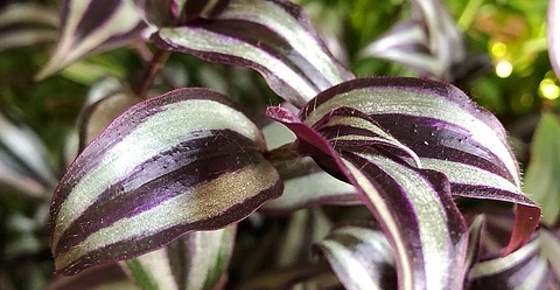
The wandering Jew plant is a common name for different species of plants that belong to the Tradescantia genus. There are around 75 different types of plants in Tradescantia genus and some are called inch plants, spiderwort, striped wandering Jew, Boat Lily, Purple Queen, or flowering inch plant. Wandering Jew plants are great house plants because they are relatively easy to care for. They are also easy to grow because the wandering Jew plant propagates easily from cuttings.
Some types of wandering Jew plants have green and gold leaves, some have reddish leaves, and others have green fuzzy leaves. There are also types of wandering Jew plants that flower. Depending on the species, the wandering Jew plant could have purple, white, or pink flowers.
How to care for wandering Jew plant : For the Tradescantia or spiderwort plant to thrive, grow in a plenty of indirect light and plant in fertile, moist potting soil with good drainage. Make sure the soil isn’t too dry or too damp and keep medium humidity levels. The ideal temperature range is between 65°F (18°C) and 75°F (23°C). You can fertilize every four weeks during the growing season with a diluted liquid houseplant fertilizer.
In this article, you will find all you need to know about this delightful houseplant. You will also get tips and ideas on how to care for your wandering Jew plants.
Wandering Jew Plant (Tradescantia or Spiderwort) – Overview of the Plant and Its Flowers
The botanical name for wandering Jew plant is Tradescantia zebrina and is also called the inch plant. However, the name wandering Jew is given to many herbaceous perennial plants in the Tradescantia genus. ( 1 )
Species of Tradescantias naturally grow outdoors in countries in Asia, Africa, Central and South America, and Australia. Varieties of wandering Jew plants also thrive well indoors, where, like their garden varieties, they grow well when it is warm, sunny, and moderately humid.
According to the United States Department of Agriculture, various varieties of Tradescantias are regarded as invasive plants in the wild. However, it is the fast-growing nature of spiderworts, wandering Jews, and inch plants that makes them perfect houseplants. ( 2 )
Many people like to grow wandering Jews or spiderworts in hanging baskets or grow them in pots to decorate a garden.
What does a wandering Jew look like?
Plants from the Tradescantia varieties have leaves that seem to grow in all directions (hence the term “wandering Jew”).
One of the distinct features about foliage on wandering Jews is that many of them have striped leaves. Sometimes, the leaves can be purple and silver stripes, whereas other types of Tradescantias have leaves that are almost all silver. ( 3 )
You may also notice that some varieties of wandering Jew plant have different colors on the underneath of the leaf. For example, the Tradescantia zebrina has green/silver leaves on the upper side and deep red or burgundy colors on the underside.
Wandering Jew flower
Wandering Jew houseplants also produce attractive flowers. These flowers can sometimes be white or can range in color from pink to various shades of lilac and purple. ( 3 )
However, plant lovers don’t usually grow wandering Jews indoors or outdoors for their blooms. It’s the beautiful variation of leaf colors that makes various types of Tradescantias so desirable houseplants.
Types of Wandering Jew (Spiderwort) Plants
The most popular types of Tradescantia plants to keep indoors are Tradescantia fluminensis ( spiderwort ), Tradescantia pallida ( purple heart ), and Tradescantia zebrina ( wandering Jew ).
Wandering Jew or inch plant ( Tradescantia zebrina )
This type of wandering Jew houseplant has purple and green leaves with a stripe pattern that resembles zebra’s stripes. There are types of wandering Jews that have bluish green leaves and purple hues on the underside.
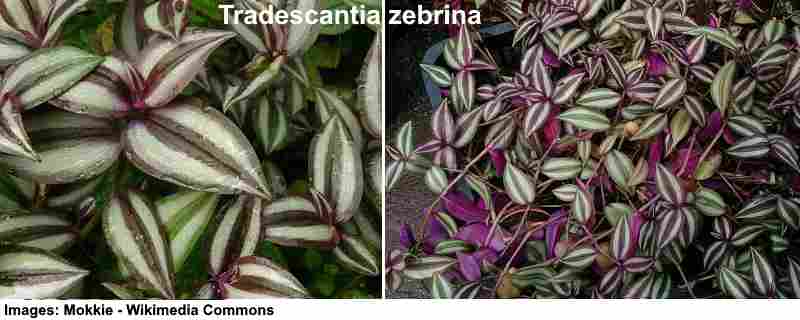
Tradescantia fluminensis (spiderwort)
There are a number of types of Tradescantia that are called spiderwort. This is distinguished from some Tradescantias as it has ovel shiny dark green leaves with pointed tips which are slightly fleshy .
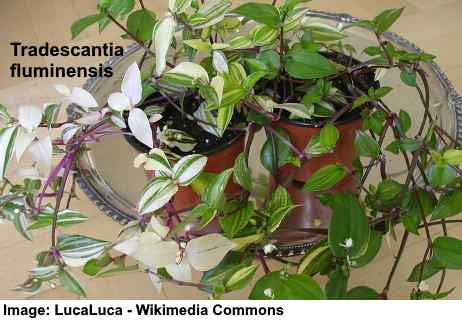
Picture of wandering Jew plant with white flowers
Tradescantia pallida (purple heart)
This type of spiderwort plant is also commonly referred to as wandering Jew. The T. pallida houseplants have vibrant purple leaves and light pink flowers when they bloom.
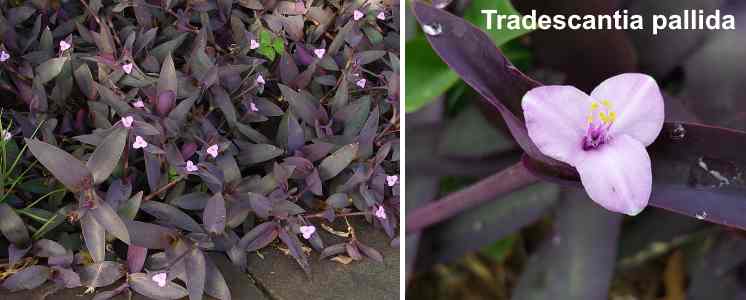
Wandering jew plant with deep purple leaves and light purplish-pink flowers
Tradescantia callisia
The leaves of T. callisia varieties are sometimes referred to as creeping inch plants. They have remarkably stripy leaves made up of green and white stripes.
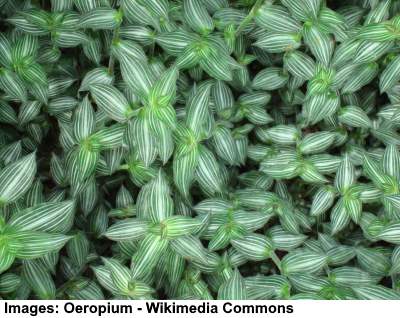
Picture of green wandering jew
Wandering Jew Plant Care (How to Grow Spiderwort or Tradescantia)
Caring for wandering Jew plants is fairly simple and straightforward. All plants in the Tradescantia genus enjoy moist soil, sunny but indirect sunlight, and warm conditions.
So, it doesn’t matter if you have fuzzy leaf Tradescantias, purple queen varieties, spiderworts, or wandering Jews, they all require the same type of care.
Light requirements for Tradescantias
To make sure that wandering Jew plants grow successfully, they require a good amount of light. This ensures that they grow with healthy leaves that have a vibrant green, silver, purple, or lilac colors.
The best place to place wandering Jew plant or spiderworts is in an east- or west-facing location. This means that they get plenty of natural light without being in direct sunlight when the sun is at its strongest.
The only exception is if you have Tradescantia pallida plants with dark purples leaves. They usually thrive in direct sunlight, although you should regularly check them in the summertime to make sure the sun isn’t too strong.
One sign that your Tradescantia isn’t getting enough light is if the color of their leaves starts to fade.
Best growing temperature for Spiderwort or Tradescantia
One of the reasons why wandering Jew plants are good for the home is that they thrive in room temperature.
The best temperatures for growing any type of Tradescantia plant is between 65°F (18°C) and 75°F (23°C). The houseplants also thrive in conditions that are described as “average humidity.”
If you grow Tradescantias outdoors, you should be aware of a drop in night temperatures and lower temperatures during winter. You should bring Tradescantias indoors if the temperature drops.
Best watering techniques for wandering Jew plant care
To care for your inch plant, spiderwort, or wandering Jew, you should keep the soil moist.
The best way to water a wandering Jew is to water the soil thoroughly and let the water drain out the bottom. Another way to water your purple house plant is to put water in the plant pot tray and allow the plant to soak up as much as it needs.
Some beginners who start caring for houseplants such as Tradescantias for the first time buy a soil moisture gauge to help get the soil moisture levels just right.
When it comes to proper watering for your wandering Jew, always make sure the soil isn’t too dry or too damp. Usually, weekly watering in the summertime is enough to keep your Tradescantia growing well.
The best fertilizer for wandering Jew houseplants
The reason why Tradescantias are so easy to care for is that they don’t usually require any feeding.
If you decide to encourage your inch plant or spiderwort to grow faster, then choose a liquid organic fertilizer mixed at half strength and use once a month.
Most houseplant growers don’t feed their wandering Jew plants in the fall or winter as they tend to become “leggy” or “straggly.”
Which type of soil to use for Tradescantias
To properly care for wandering Jew varieties of houseplants, you only need to plant them in regular potting soil.
How to prune wandering Jew plants
In time, Tradescantia plants require some cutting back and pruning. This helps to give your houseplant a bushier appearance and also gives you plenty of cuttings to propagate.
For Tradescantia pruning, you just need to pinch off the stem tips to leave about ¾ of the length. This will encourage your plant to grow better and become more attractive.
Growing Plants from Wandering Jew Cuttings
Even for the most novice of houseplant owners, propagating any type of Tradescantia plant is very easy. After you have cut back your “leggy” wandering Jew stems, you will have a large number of cuttings that you can use to grow new house plants.
How to propagate wandering Jew plant leaves
To prepare your wandering Jew cuttings or purple heart plant cuttings for propagation, you need a couple of stems about 1-2 inches long. Remove all the leaves apart from 2 or 3 at the end of the stem.
There are 2 ways you can grow wandering Jew plants from cutting:
- The first way is to just put a cutting in potting soil and wait for it to grow. All you have to do is make sure that the soil is kept moist and not overly damp.
- The other way to grow a Tradescantia from a cutting is to put the stem in water. You should notice that new roots start to grow within a week. When you notice new roots growing, you can transfer your cuttings to a pot to grow a new houseplant.
Wandering Jew Outdoor Plant Care
Tradescantia plants are great garden plants and grow well outdoors in warmer zones in the U.S. (USDA growing zones 9-11). In fact, it is because they grow so well outside in warmer countries and are quite invasive that they are classed as a weed in certain countries.
You can easily care for any Tradescantia plants to add color and beauty to your garden. Purple hanging plants or wandering Jew vines with stripy leaves can grace any patio, doorway, or garden area.
As with caring for wandering Jews or spiderworts indoors, Tradescantia plants growing outdoor should be protected from direct sunlight. So, place your plants in shady areas of the garden. But it’s good to remember that some bright light will help the wandering Jew plant produce more flowers.
Temperature
Also, frost can damage the plant, so, if you live in areas where fall and winter temperatures drop below 10°F (12°C), you should take them indoor and continue to grow them as houseplants.
Problems with Wandering Jew Plant (Spiderwort)
Even though it is relatively easy to care for wandering Jew plants, you can still come across certain problems.
Let’s look at some growing tips for Tradescantia plants to avoid or remedy some common problems.
The most common pest when growing wandering Jews indoors are bugs such as spider mites or aphids . The appearance of these pests on your bushy spiderwort or inch plant may be a sign that conditions are too dry.
To help remedy the problems of pests on your Tradescantia, mist the leaves regularly and make sure the soil is moist enough. You may need to wash off the mites with water to help get rid of the infestation.
One of the beauties about caring for wandering Jew plants indoors or outdoors is that they are not susceptible to disease. Usually, any discoloration of the leaves or poor growth is connected to the soil being too dry or too damp.
Fungal infections
Overwatering spiderworts, inch plants, or wandering Jews can cause a fungal growth called botrytis to develop in the roots.
Brown leaves
As with most problems associated with caring for Tradescantias, brown leaves can also indicate that the growing environment isn’t right. The leaves of your wandering Jew could have turned brown because of too much or too little sunlight. Also, too much watering can affect leaf health.
Where to Buy Wandering Jew Plants
Many garden centers and online stores stock many different varieties of wandering Jews. You will also find that Tradescantia cuttings are available online.
Because many different types of wandering Jews are so easy to grow yourself, you could ask a friend for a cutting if they have the plant. You can also get more Tradescantia houseplant or garden plants by propagating cuttings from plants you already have.
FAQ Related to Wandering Jew Plant (Tradescantia)
Do they need any pruning.
To properly care for wandering Jews, the leaves and stems require pruning. The stems can grow quite long and start losing their leaves from the base. The best time to prune any Tradescantia plant is just before the growing season in late winter or early spring.
You may also find that Tradescantias grow better if you give them a mild prune in late summer.
How to prevent wandering Jew roots from rotting?
Go easy on the watering to stop Tradescantia plants’ roots from rotting. Water them enough to keep the soil moist during summertime and only occasionally in the winter.
Are wandering Jew plant leaves toxic to animals?
While not toxic to cats or dogs, the leaves of wandering Jew plants can cause irritation. If you have pets that like to nibble on leaves, you can still benefit from the beauty of Tradescantias if you grow the outdoor plant in hanging baskets.
Can I grow my Tradescantia plant outdoors?
Yes, you certainly can. Wandering Jew plants grow well out of doors in warm climates. During the summertime, you can move your indoor houseplants to the garden and place them away from direct sunlight.
Dashes of purple colors, bright pinks, or interesting green and purple stripped leaves can make an interesting feature in any garden or balcony.
Can you train a wandering Jew plant?
Tradescantia plants are easy to train because their stems can grow very long and you can wrap them around objects. Wandering Jew plant stems can grow up on trellises or obelisks or up around any other item.
Heavily pruning wandering Jews in late winter can also help to train the plant to grow into a colorful bush.
How fast does wandering Jew plant grow?
Tradescantia cuttings should start growing roots within a week or so. Once the plant is established, you can expect it to grow about an inch every week. Some people claim this is the reason that some Tradescantias are called inch plants.
Can Tradescantia houseplants cause allergies?
The sap of wandering Jew plants or prolonged skin exposure to its leaves could cause allergic reactions.
The journal Allergy reports that indoor plants such as Tradescantia can also cause symptoms such as itching of the throat, swelling, wheezing, and runny eyes and nose. ( 4 )
Do wandering Jew varieties have any health benefits?
Although not widely used, extracts from Tradescantia zebrina have certain medicinal properties. You can buy inch plant herbal liquid extracts that are said to have many antioxidant properties.
Researchers have found that therapeutic compounds in Tradescantia extracts have antibacterial, anticancer, and antioxidant uses. ( 5 )
Related articles:
- Moses In Cradle Care: How to Grow Tradescantia spathacea
- Chinese Money Plant Care: How to Grow Pilea Peperomioides
- Dracaena Marginata Plant Care: How to Grow Madagascar Dragon Tree
Grow. Play. Every Day!

- House & Home
- Houseplants
Wandering Jew Care: How to Grow a Flourishing Inch Plant (Tradescantia Zebrina)
Tradescantia zebrina (commonly known as wandering Jew, spiderwort, or inch plant) is popular for a reason: This beginner-friendly houseplant is low-maintenance and grows quickly. It’s also super easy to propagate more plants so you can fill your home with more of the colorful striped foliage the species is known for.
Written by Linda Ly

When it comes to vigorous, colorful, and easy-to-grow hanging houseplants, there aren’t many that can compare to Tradescantia zebrina (known more commonly as wandering Jew—and I’ll touch on the history of that name below). Whether you’re a houseplant beginner or a veteran, most indoor gardeners have owned one of these potted plants at some point.
Keep reading for everything you need to know about Tradescantia zebrina and growing this stunning houseplant in your own home.
Disclosure: If you shop from my article or make a purchase through one of my links, I may receive commissions on some of the products I recommend.

About inch plants
Natural habitat.
Tradescantia zebrina is a native of Central and South America, from Mexico down to Colombia, as well as the Caribbean. Here, it forms part of the undergrowth in lightly forested and often very moist areas. It can form very dense, wide mats thanks to its creeping growth pattern and ability to throw roots extremely quickly.
Unfortunately, its vigorous growth has also made Tradescantia zebrina an invasive plant in some regions. This includes Hawaii, Brazil, and Australia, where the species easily takes hold in moist, forested areas.
As a 2019 study carried out in the Brazilian Atlantic Rainforest notes, this is problematic due to the species choking out native plants.
Some of the above was caused by careless gardeners allowing bits of the plant to get into the wild, where they quickly root. If you’d like to grow spiderworts like this one in your garden, please make sure to dispose properly of any trimmings left after pruning!
This also applies to zebrina’s popular cousins, like Tradescantia fluminensis, T. pallida, and T. spathacea.
Description
It’s not difficult to see why Tradescantia zebrina gained popularity as a houseplant. Wandering spiderwort plants (not to be confused with spider plants , another beginner-friendly species) are low-maintenance and grow just about anywhere—they even just grow in water !
Easy care and quick growth aside, spiderworts are also just good-looking plants. The pointed, oval leaves on thin, fleshy stems overlap slightly and are characterized by their zebra pattern in purple and silvery green. The leaf undersides are deep purple in color and the tiny, three-petaled flowers are bright pink.
Although this species is naturally a creeping plant, it’s often grown indoors in hanging planters. As long as the plant is provided with enough light, the foliage will be very dense and brightly colored, forming a spectacular waterfall that can reach more than 3 feet in length.
What’s in a name? In the case of common houseplants, sometimes a lot.
Tradescantia zebrina is a classic houseplant (I found mention of it in a 1964 German book about houseplants, but it’s probably been around longer than that!) and among most English speakers, it has long been known as wandering Jew. This is probably a reference to the “wandering” nature of the plant, as it does have a creeping growth pattern.
The legend of the wandering Jew is hundreds of years old and is now commonly considered to be rooted in antisemitism. It describes a Jewish man cursed to walk the planet until the Second Coming because he taunted Jesus on his way to the cross.
Because of this, the plant name has partly fallen out of fashion and has been the source of much debate in the plant world over the past few years.
Some plant enthusiasts have embraced the alternative “wandering dude,” which I personally think is a great option.
“Inch plant” (houseplant enthusiasts don’t agree on whether this refers to the fact that it can grow an inch a day, or that you only need an inch of stem to propagate it), “spiderwort,” or “wandering spiderwort” are also popular alternatives, though these are common names for other Tradescantia varieties, such as Tradescantia Nanouk.
The best way to avoid any confusion is to just stick to the scientific name.

Inch plant varieties
There are three subspecies of inch plant (wandering Jew): Tradescantia zebrina var. zebrina, var. flocculosa, and var. mollipila. Unsurprisingly, after it having been a popular houseplant for so many years, nurseries have also managed to create a whole bunch of cultivars through selective cultivation.
A few of the popular Tradescantia zebrina cultivars you may come across in your local plant store include, but are certainly not limited to:
- Tradescantia zebrina ‘Quadricolor’: Yep, as the name suggests, this one adds an extra color to the mix. The leaves are cream, pink-purple, light green, and dark green.
- Tradescantia zebrina ‘Burgundy’: Characterized by its very dark purple coloration.
- Tradescantia zebrina ‘Silver Plus’: Less purple, more shiny silver.
- Tradescantia zebrina ‘Red Gem’: Less silver, more intense (light) purple.
- Tradescantia zebrina ‘Purple Joy’: Less silver, more dark purple.
- Tradescantia zebrina ‘Tikal’: A rare, naturally occurring variety that collectors pay a pretty penny for.
Do keep in mind that most of these cultivars aren’t patented and the amount of mislabeling and variation within a cultivar are both huge. Just growing your wandering Jew in lower-light conditions can completely change the way it looks, so it’s not surprising that confusion sometimes reigns supreme.
Luckily, care is the same across all cultivars, so your best bet is to just enjoy your plant even if you’re not sure what Tradescantia variety you’re dealing with!
Where to buy wandering Jew plants:
- California Tropicals
- Daylily Nursery
- The Green Escape

Caring for an inch plant
Light and temperature.
It’s important to provide your Tradescantia zebrina with enough light. It’s tempting to use plants to brighten up dark, shaded spots in your home, but that just doesn’t work with this one: It loses its dense growth pattern and beautiful coloration in low light.
To prevent your wandering dude plant from growing sparse and green, place it near a window that gets bright indirect light. Some full sun isn’t a problem either, but do make sure you acclimate it gradually to a higher light location.
Temperature-wise, this species is a lot hardier than many of the tender tropicals we like to grow in our homes (like Anthurium andraeanum and Begonia maculata ).
Wandering dude plants can handle a very wide range of temps, making it perfect for those chillier windowsills that your other plants may not appreciate. Room temperature is ideal, but anything between 50°F to 85°F will keep them happy.
Water and humidity
Your Tradescantia zebrina will appreciate lightly moist soil. You can water a bit more during the summer months, when the plant is actively growing and needs a lot of moisture, and less during winter, when soil tends to take significantly longer to dry.
If you’re not sure whether it’s time to water your wandering Jew plant yet, you can always turn to the age-old trick of sticking a finger in the soil.
- If it still feels damp, wait a little longer, until the first inch or two has dried.
- If it feels bone dry, you’ve waited too long; you may also see limp leaves on your plant at this point. It’ll bounce back, but not always without lasting damage.
- If the soil feels wet, you watered too much and need to keep an eye out for root rot.
As for humidity, given its rather wet natural habitat, wandering Jew does appreciate higher air moisture levels. The great thing is, though, that it doesn’t demand it. As long as you keep its soil lightly moist and the air isn’t extremely dry, your plant should do well.
Soil and planting
Wandering Jew is not fussy about its potting mixture at all. I’ve grown it in pure houseplant potting soil with no additives. If you do want to take things to the next level, you can add some perlite and/or peat moss, although this is really not a must.
Most houseplant enthusiasts like to place their wandering Jew in a hanging planter so they can enjoy the look of the leaves cascading down. This is not a must, though. You can also emphasize the species’ creeping growth habit by filling up a large, shallow planter, growing it in a terrarium, or even keeping it in water on a semi-permanent basis.
Recommended products for wandering Jew plant care:
- FoxFarm Ocean Forest Potting Soil
- Espoma Organic Potting Mix
- Perfect Plants Organic Perlite
Fertilizing
Like most other houseplants, Tradescantia zebrina appreciates a bit of fertilizer during the growing season, which extends from spring to early fall. You can use a normal houseplant fertilizer according to the instructions on the bottle.
Don’t fertilize during the winter months unless your plant is growing well. It doesn’t need extra nutrients if it’s inactive.
Recommended fertilizers for wandering Jew plants:
- Houseplant Resource Center Liquid Fertilizer for Houseplants
- Instant Biologics Instant Plant Food (Fizzing Nutrient Tablets)
- Maxsea All-Purpose Seaweed Plant Food
Pruning
There’s a good chance you’ll have to prune your Tradescantia zebrina regularly, because as I mentioned, this is a very quick grower. It also roots very easily, so any trimmings can be replanted! I’ll describe how to do this in the section on propagation below.
Aside from stem trimming, you can remove any dead leaves, which are bound to pop up from time to time in very dense plants like this species.
Dividing or repotting
Inch plants don’t grow by producing plantlets at their base like many other houseplants (such as spider plants ) do. Instead, inch plants spread by rooting along the stems.
This means that division is not really the way to go; keeping these plants manageable is usually done through pruning. You can shape your plant by pinching off any long, leggy stems to create a fuller appearance and control its spread.
You’ll notice that Tradescantia really doesn’t mind being a bit cramped in its planter. Still, it’s a good idea to provide your plant with some fresh soil every year or two by repotting it.

Propagating an inch plant
If you’ve never propagated a houseplant before, this is truly one of the best species to start with. It’s known for rooting extremely quickly in both water and soil, meaning it’s easy to fill endless planters to keep or give away.
All you need to propagate your Tradescantia zebrina is a pair of clean scissors. Here’s how you do it:
- Snip the ends off existing branches. An inch or two with a few leaves works best.
- Remove the leaves at the bottom so part of the stem is exposed.
- Place the cutting in a glass of water to root or plant it directly in soil. You can put cuttings back in the mother plant’s pot to give her a fuller appearance on top.
- It can take a little longer during the winter months, but the first roots should appear within a week or so. You can give soil cuttings a slight tug to verify they’ve rooted.
- Once the first signs of new foliage appear, you’ll know your propagation attempt has been a success!
- If you propagated in water, you can leave the rooted cuttings in water almost indefinitely, although you can also pot them up in fresh soil.

Common questions about inch plant care
How do i make a wandering jew plant bushy.
By their very nature, wandering Jew plants are not bushy. Their creeping growth habit means they naturally grow leggy over time, especially in containers.
However, you can mimic a fuller appearance by strategically pinching off any long, spindly stems to shape the plant more. These stems can also be replanted near the mother plant.
As the baby plants grow, they’ll help fill in sparse areas and create the illusion of a bushy wandering Jew.
How long do wandering Jew plants live?
Wandering Jew plants have a limited lifespan of just a few years, and as a potted plant, you’ll notice your wandering Jew becoming very leggy after just two to three years.
Unlike other fast-growing plants that benefit from pruning, cutting back a wandering Jew doesn’t work well to renew its growth; it simply controls the spread.
The best way to keep your plant coming back year after year is to propagate new plants from stem cuttings, which—fortunately—is super easy with a high success rate.
Is wandering Jew perennial?
Wandering Jew (Tradescantia zebrina) is a trailing evergreen perennial in its native habitat (USDA hardiness zones 9 through 12). Where it’s not winter hardy, wandering Jew is grown year-round as a houseplant.
Are wandering Jew plants toxic to cats and dogs?
Wandering Jew is not considered outright toxic, but it can cause some skin irritation. If your pet gets into your plant, don’t worry too much, although it can be a good idea to have a look in its mouth to make sure there’s no excessive swelling. Be sure to offer water. To prevent skin rash, it can be a good idea to wear gloves if you need to handle your wandering Jew plant. This especially applies if you have sensitive skin.
https://www.cabi.org/isc/datasheet/110354
Racism in Taxonomy: What’s in a Name?
Chiba de Castro, W. A., Xavier, R. O., Garrido, F. H., Romero, J. H., Peres, C. K., & da Luz, R. C. (2019). Fraying around the edges: negative effects of the invasive Tradescantia zebrina Hort. ex Bosse (Commelinaceae) on tree regeneration in the Atlantic Forest under different competitive and environmental conditions. Journal of Plant Ecology, 12(4), 713-721.
Encke, F. (1964). Pflanzen fur Zimmer und Balkon; Auswahl, Pflege, Vermehrung.
I'm a plant lover, passionate road-tripper, and cookbook author whose expert advice and bestselling books have been featured in Time, Outside, HGTV, and Food & Wine. The National Parks Cookbook is my latest book. Garden Betty is where I write about modern homesteading, farm-to-table cooking, and outdoor adventuring—all that encompass a life well-lived outdoors. After all, the secret to a good life is... Read more »
We bought a full grown Bolivian Jewel mid summer last year. It was in a 14” raised pot and flowing 2 foot over the sides. It was beautiful next to our fountain outside. We live in Minnesota so we had to discard it in the late fall since we had no place to care for it in the house. Since we can’t find another like it we’d like to plant one from scratch but how. We still have the pot and riser but have no idea how to start from that. One plant, a few or just how many to make a bushy over grown plant so it looks like the one we purchased last year. Does this make sense or should we just forget it since it is already the middle of May. The greenhouse that we bought it from last summer doesn’t have any this year, just small ones in 4” pots. Thanks
If you can only grow it as an annual (and won’t be overwintering it indoors), you can plant a few smaller ones together to make them look fuller as they grow.
It seems counterproductive to talk about the problematic origin of the name wandering Jew, recommend multiple alternative names (including scientific), but then continue to call it wandering Jew in the rest of the article. If the name is anti-Semitic just set a good example and use a different name.
Leave a Reply Cancel reply
Your email address will not be published. All fields are required.
Save my name and email in this browser for the next time I comment.
This site uses Akismet to reduce spam. Learn how your comment data is processed .
Recommended Reads
- Garden of eatin’
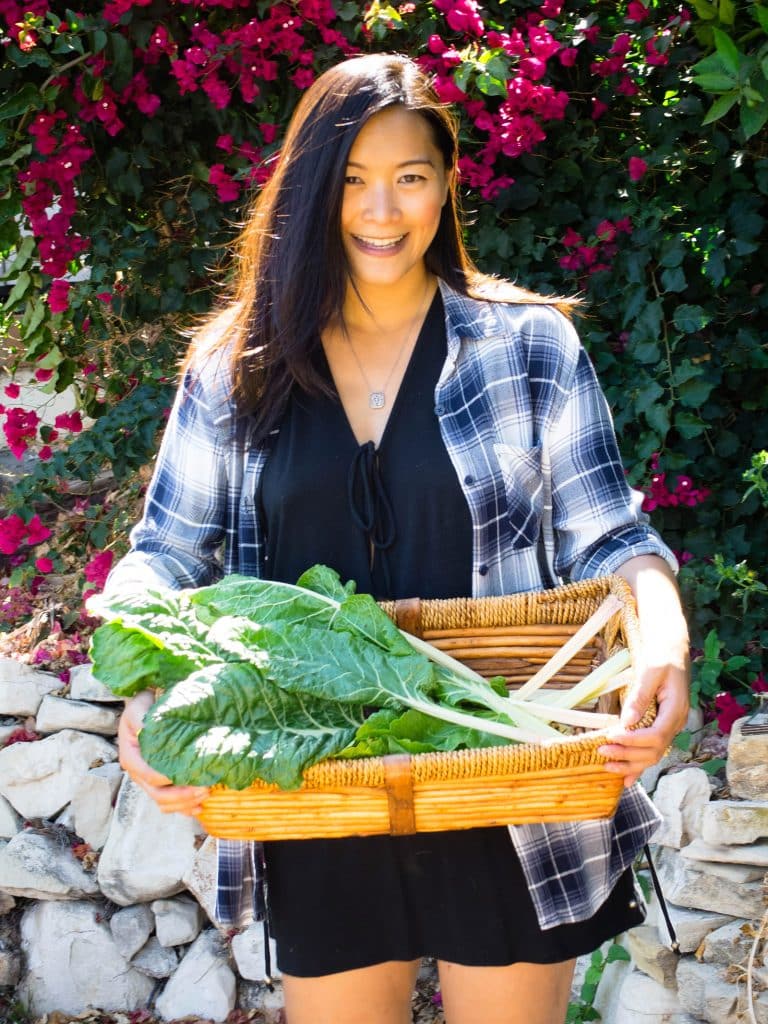
What I Always Plant Midsummer for an Epic Fall Harvest
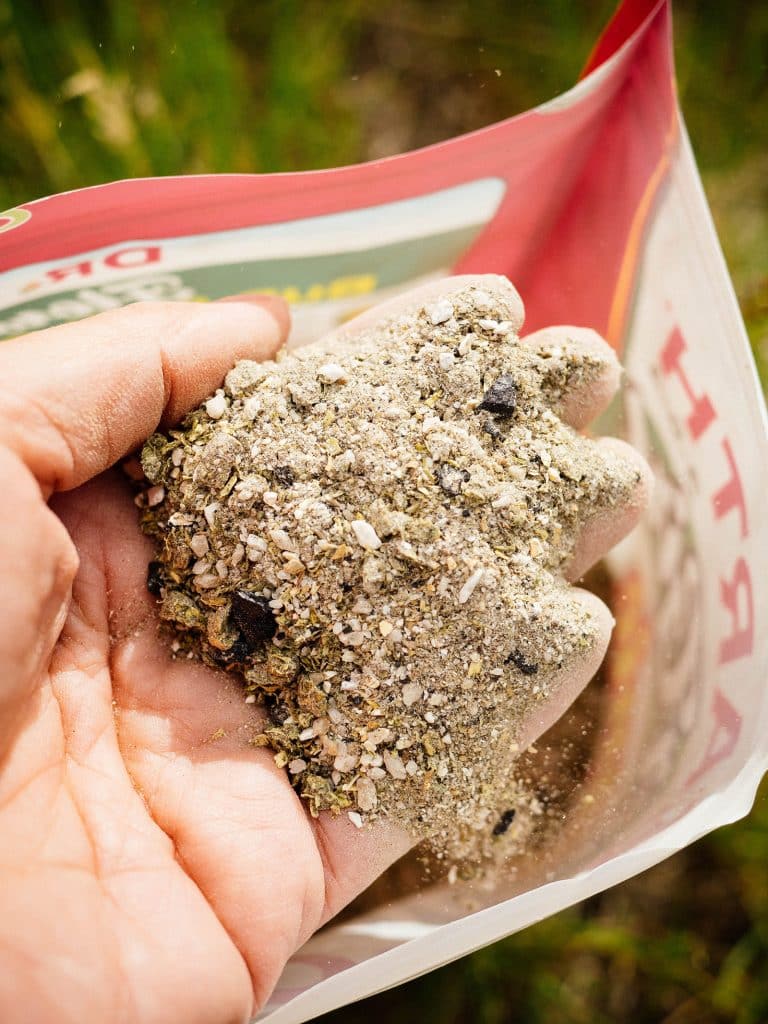
How (Not) to Fertilize Your Plants This Summer
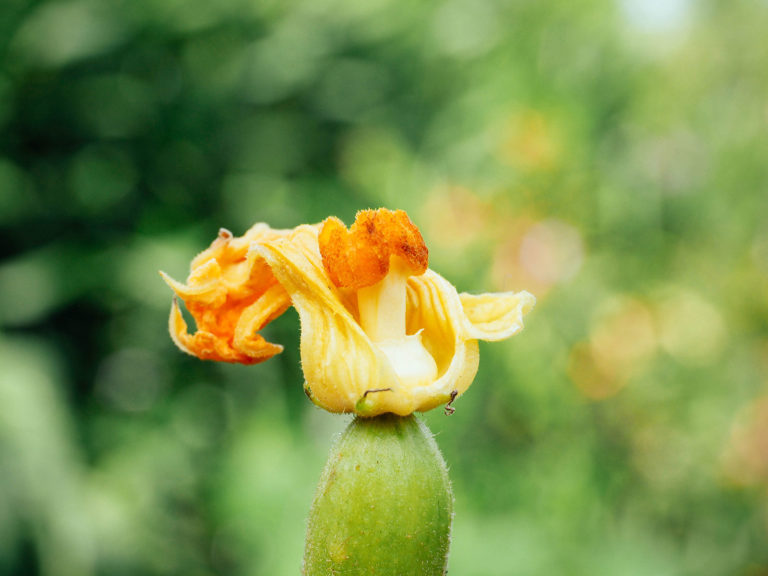
How to Pollinate Squash by Hand (and Why Your Plants Have Lots of Flowers but No Fruits)
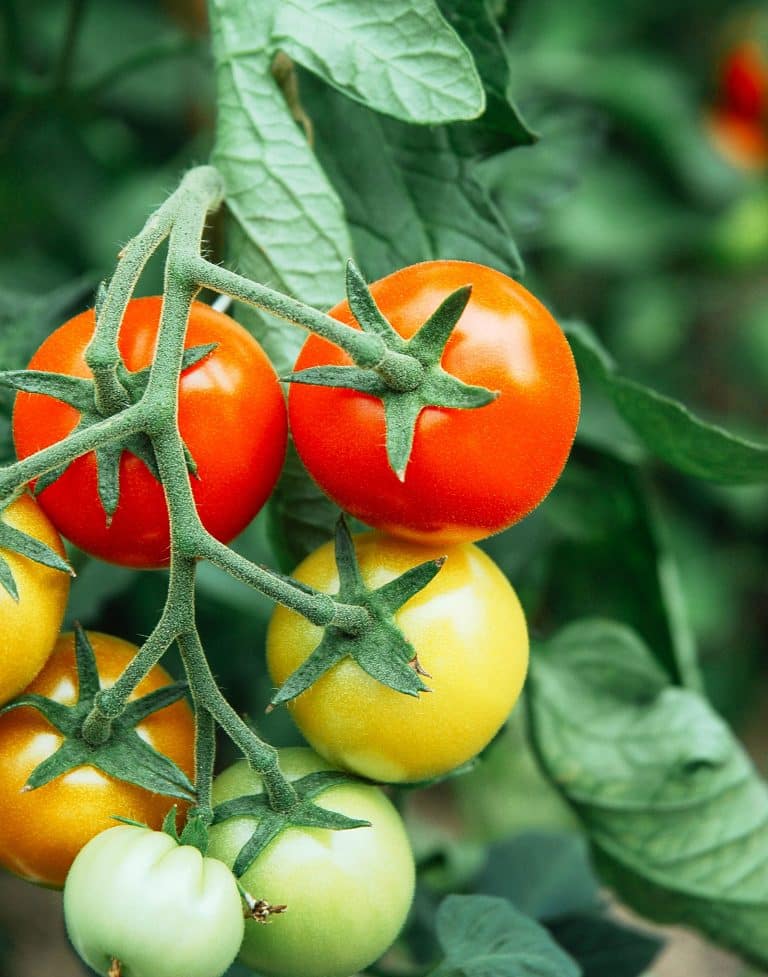
The Best Time to Pick Tomatoes for Peak Quality (It’s Not What You Think!)

What You Should Know Before Buying Land (My Real-Life Tips)

Construction Loans: What I Wish I’d Known As a First-Time Borrower

Dark Room? 9 Actually Low-Light Plants That Don’t Need a Lot of Sun

Getting Rid of Fungus Gnats: 11 Remedies That Really Work
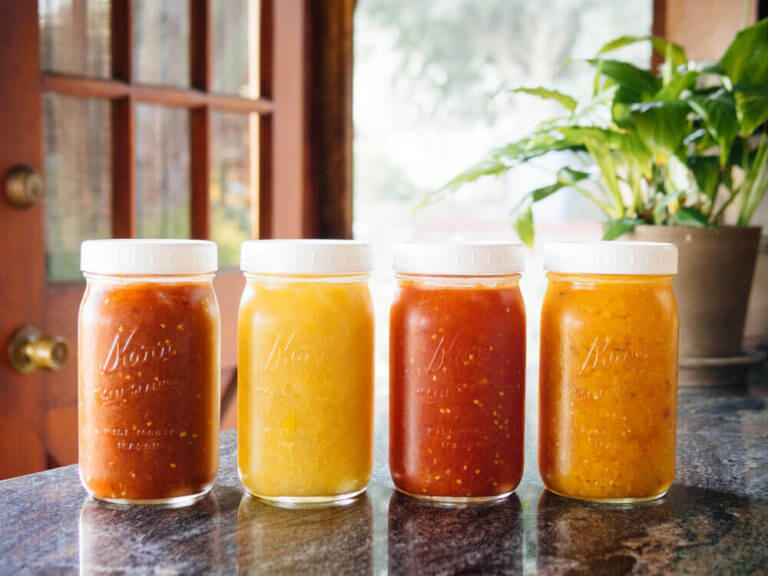
Easy Peasy Homemade Tomato Sauce (No Peeling Required)
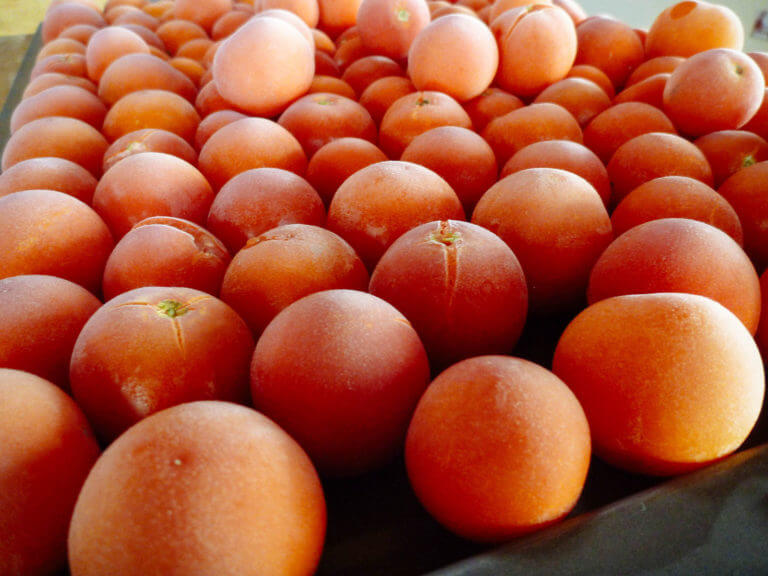
This Is the Best Way to Freeze Fresh Tomatoes

Fiery Fermented Hot Sauce: 3 Simple Variations
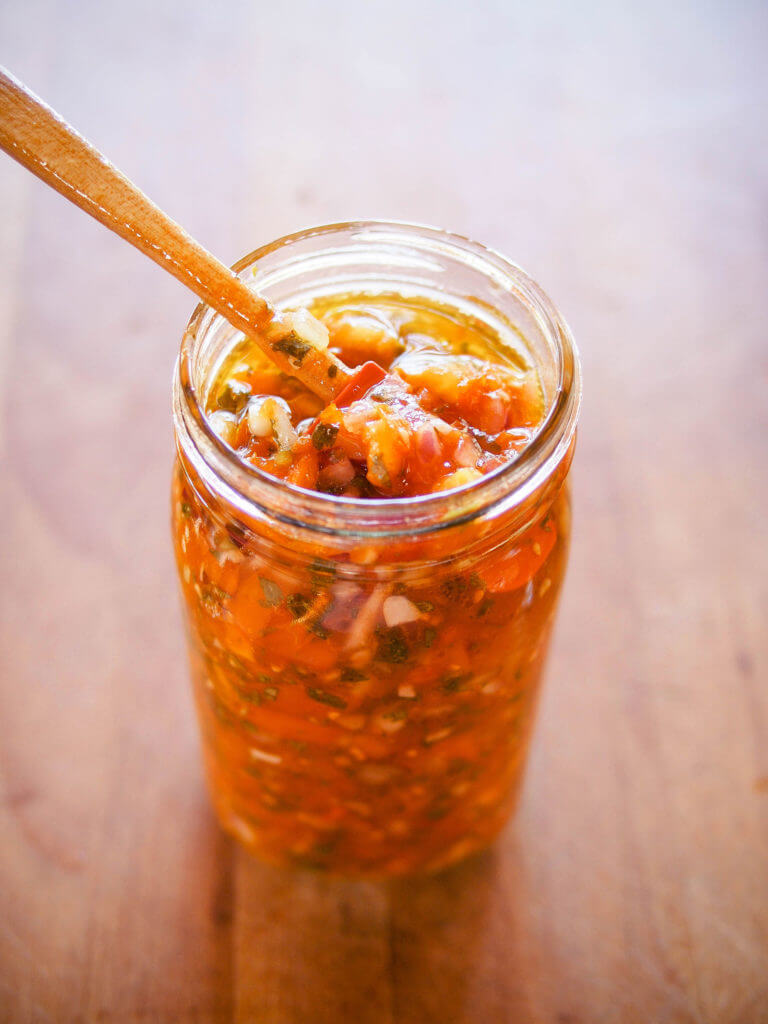
Spicy Fermented Salsa: Take Tomatoes to the Next Level
Want to level up your garden this year.
Sign up for my free, never-boring newsletter and every week you’ll get the game-changing emails you wish you’d gotten sooner.
- About Linda Ly
- What’s In My Garden
- Lazy Gardening Academy
- Sponsorships
- Site Policies

Back to the top
Disclosure: Garden Betty independently selects products to feature on this site. I may receive a commission when you buy something through one of my links. As an Amazon Associate, I earn from qualifying purchases.
© 2024 Garden Betty. All Rights Reserved.


Wandering Jew Plant – Ultimate Care Guide
By: Author Daniel
Posted on Last updated: September 18, 2023

Sharing is caring!
- Facebook 60
You are reading this guide to learn more about the Wandering Jew Plant and its care . I have had this plant at home for many years and write about all the growing aspects in this guide.
Wandering Jew Plant Care Takeaways
What is the wandering jew plant.
The Wandering Jew, or Tradescantia zebrina, by its scientific name (old name = Zebrina pendula) is native to Mexico. It is not to be confused with Tradescantia albiflora, which also goes by Wandering Jew and has very similar care needs.
Tradescantia zebrina has attractive foliage, sporting exciting zebra-patterned leaves. It also flowers. But when kept as a houseplant, this rarely ever happens. It is a fast-growing and excellent groundcover, according to the University of Florida .

W andering Jew Plant Care
To keep your Wandering Jew plant thriving, ensure it receives bright, indirect sunlight. Keep it in average room temperatures of 60-75°F (16-24°C). Fertilize once a month during spring and summer. In winter, relocate the plant to a cooler area with temperatures of 54-59°F (12-15°C).
Table of Contents
Tradescantia zebrina Growing guide
Tradescantia zebrina care is pretty straightforward, but it certainly can’t hurt to glance at the most important things to consider when caring about this herbaceous perennial plant.
So, without further ado, let’s see how you can make your Wandering Jew, aka the Inch plant, as happy as possible.
Any good potting soil will do for your Wandering Jew. For instance, this could be Miracle Gro potting soil readily available online in stores like Amazon.
But these plants not only feel very comfortable in soil but can also be kept in hydroponics .
Sunlight is a vital aspect when it comes to the well-being of most houseplants. Some houseplants do well with moderate sunlight, while others only thrive (or flower) when a certain level of sunlight is guaranteed.
The Wandering Jew does best in bright, indirect sunlight .
If you are unsure what that means, please look at our Light Levels article.
The Wandering Jew, a tropical native, thrives best when the root ball is always well moisturized. Still, waterlogging should be avoided whenever possible, as this could lead to root rot .

This tropical plant does not enjoy limy water. Use soft water whenever possible. Rainwater and distilled water are very good choices.
Temperature
People who own an Inch plant and keep it outside run the risk of exposing it to cold temperatures. This is where indoor plant owners have the upper hand.
Wandering Jews can thrive with average room temperatures of 60 to 75°F (16 to 24°C) if it doesn’t drop for long periods. Anything below 12°C for an extended period could be fatal for your Wandering Jew.
Wandering Jews prefer a humidity of around 70%
The perennial, herbaceous Wandering Jew plant is native to Mexico, Central America, and Colombia, so it should not surprise you that it likes a good deal of humidity.
To ensure high humidity levels, regularly misting your plant is a very good idea. A hand mister filled with water does the trick.
As for the location, you may want to keep your Wandering Jew in the bathroom , as this is usually the place in the house with the highest humidity.
Feed your plant once a month during spring and summer. In winter, fertilizing is not necessary.
Also, fertilization of the Wandering Jew is only necessary from the second year of cultivation or after repotting.
Propagation
It is best propagated through stem tip cuttings. Propagating the Wandering Jew is an easy task.
Wandering Jews don’t get very tall. They might reach a height of about 14 inches (36 cm) when kept indoors. They spread to about 10 inches (25 cm).
(Re)potting
The thing with the Wandering Jew is that it grows fast , hence its nickname “Inch plant.” Because of its fast-growing pace, the plant usually gets very leggy, and leaves are often lost near the base of the plant.
Repotting is pivotal for keeping the root system healthy regardless of the actual plant species. However, how often a houseplant needs to be repotted depends on various factors.
Some houseplants grow incredibly fast, so they need to be repotted often. Others, on the other hand, grow very slowly, so repotting is not a top priority.
That said, repotting your Wandering Jew occasionally is a good idea.
How long does a Wandering Jew live?
As far as the longevity of Wandering Jews goes, they often don’t get older than 2 to 3 years.

Wandering Jew Watering
Water about once every 5-7 days in spring and summer. Keep the soil slightly humid. Do not let the Wandering Jew dry out between waterings. Use your index finger to check if the soil is dry down 1-2 inches of soil (2.5 – 5 cm).
Reduce watering to every 10-14 days in autumn and winter.
Wandering Jew Propagation
The Wandering Jew roots very easily . The plant can easily be propagated through stem tip cuttings.
When propagating your Wandering Jew, make sure that your plant is in a healthy condition.
Please follow our step-to-step guide to propagate your Wandering Jew through stem tip cuttings.
Propagation through stem tip cuttings
- Identify the plant that you want to replicate. It should have healthy growth and plenty of stems.
- Make clean cuts on sections that are three to six inches in length .
- Use a sharp knife and carefully cut the leaves on the stem’s bottom half.
- If you want, you can dip the exposed end of the stem in a rooting hormone . This will speed up the rooting process. However , it is unnecessary .
- Place your stem tip cuttings into a pot with fresh soil after thoroughly watering the potting mixture.
- Use a clear plastic bag to hold in moisture, taking it off to water weekly .
- Keep your eyes on the plant for new growth . You should start to see roots in about two to three weeks . Once this happens, transfer the plant babies to a larger pot.
Note: Instead of rooting your stem tip cuttings directly in soil, you could also root them in water .
Wandering Jew Pest Control
Wandering Jews are prone to aphids and spider mites attacks. So, you will need to look out for these two little pests.
Some of these are known to cause defoliation, while others can kill the plant altogether. Depending on the severity of the infestation, you may need to use chemicals or insecticides .
Aphids on my Inch Plant
The Wandering Jew is not particularly susceptible to plant diseases or pests. Yet, you might have to deal with an aphid attack at some point. These parasites pierce the leaves of their host plant and suck their sap.
Like scale insects, they excrete sticky honeydew, by which you can immediately recognize the infestation.
Aphids can multiply explosively, especially in warm , dry environments.
As a preventive measure, ensure regular watering and occasional misting of your Wandering Jew.
The best way to combat aphids is to control them mechanically by rinsing them off the plant with water . Isolate the plant from the rest of the collection.
Pest Prevention
To prevent the Wandering Jew from pest infestations, plucking dried leaves regularly makes sense as well as using neem oil. The dried leaves lying on the substrate must be removed. Otherwise, there is a risk of rotting or infestation by parasites and fungi .
Wandering Jew Problems
Brown leaf tips.
Brown leaf tips is a very common problem with a wide variety of houseplant. Depending on the species, the causes for this problem can be very different, though.
So what causes leaves to turn brown with Wandering Jews?
My Wandering Jew has only green leaves (not enough variegation)
If you do own a variegated Wandering Jew but only see a great amount of non-variegated leaves, chances are that your plant does not get enough sunlight .
To solve the problem, allow your Wandering Jew some bright, indirect sunlight by placing it in a sunnier location.
Fading leaves
If your inch plant’s foliage is suddenly losing color and sports fading leaves, this is another sign that it does not get enough sunlight .
Dropping leaves
Dropping leaves is another very common problem many plant parents must deal with regularly . If your Wandering Jew drops leaves, this is usually due to too low or too high temperatures .
In summer , ensure your Wandering Jew is exposed to average room temperatures.
In winter , it should be kept in a cooler environment.
Is Wandering Jew care difficult?
Wandering Jews are considered low-maintenance plants and are perfectly suitable for beginners.
They do well at average room temperatures, don’t demand a very high level of humidity (which is sometimes difficult to achieve in a home environment), and it is very easy to propagate them through stem tip cuttings.
Which plant species are commonly referred to as “Wandering Jew”?
Tradescantia zebrina as well as Tradescantia albiflora.
What is the difference between Tradescantia zebrina and Zebrina pendula?
There is no difference between Tradescantia zebrina and Zebrina pendula. Zebrina pendula is just the old name for Tradescantia zebrina.
Does my Wandering Jew flower at all?
Wandering Jews are indeed flowering plants. However, when kept indoors, they very rarely flower.
How long can you keep a Wandering Jew?
If you don’t propagate your Wandering Jew, you can keep it for about three years. After that period, the quality of your Wandering Jew will most likely decrease. If you regularly propagate your leafy friend through stem tip cuttings, you can keep it indefinitely.
Any display tips for Wandering Jews?
Wandering Jews look great in hanging planters!
Is the Wandering Jew toxic to cats?
The Wandering Jew plant is toxic to cats. Therefore, you have to keep your cat away from this plant.
Is the Wandering Jew toxic to dogs?
Yes, the Wandering Jew plant is toxic to dogs. Therefore, you must ensure your dog does not come in contact with this plant.
What are the health benefits of Tradescantia zebrina, if any?
Not only is The Wandering Jew a beautiful houseplant famous for its striking foliage, but it also presents several health benefits for humans. It is especially known for its antioxidant and antibacterial activity, and it is widely used in Traditional Medicine in several countries. Tradescantia zebrina is also believed to be a valuable source for treating kidney diseases.
The Last Zebrina
The Wandering Jew is a great houseplant that looks stunning in hanging planters. Its care is easy apart from its humidity-loving nature.

Daniel has been a plant enthusiast for over 20 years. He owns hundreds of houseplants and prepares for the chili growing seasons yearly with great anticipation. His favorite plants are plant species in the Araceae family, such as Monstera, Philodendron, and Anthurium. He also loves gardening and is growing hot peppers, tomatoes, and many more vegetables.
Related Posts
(image credits, IG:oohyouplantsy) I have a hide-away in my home that I escape to for…
How much light does my plant need? This is a relevant question as too little…
I love plants that offer an eye-catching burst of color. They sure put a smile…
Most of the 45+ species in the Monstera genus are famous for their unusual leaves…
One of the rarest Anthuriums is the Anthurium Reflexinervium, a gorgeous plant naturally found only…
Hoya Lauterbachii belongs to Hoyas's family, which are known to be the largest plants on…
Wandering Jew Plants Guide: How to Grow & Care for “Tradescantia zebrina”
It might surprise you to learn that “the wandering Jew” isn’t a single plant, its name used to describe a collection of plants in the Tradescantia genus.
Many countries around the world view the wandering Jew as an invasive species. Therefore, you won’t find many of them as regular additions to gardens . However, the vine makes for an excellent indoor plant .
Table of Contents
Quick Facts
Wandering jew plant varieties.
The wandering Jew refers to three different plants in the Tradescantia genus. The three varieties are the zebrina, fluminensis, and the pallida.
Tradescantia Zebrina
The zebrina is the most common of the three species, and it features dark-green foliage that contrasts against the brilliant-white three-petal flowers the plant produces.
As you can imagine, the plant also gets part of its name from the zebra-like foliage. The center of the leaf id has a creamy-white color, and the outer trimming of the leaves has a silver lining.
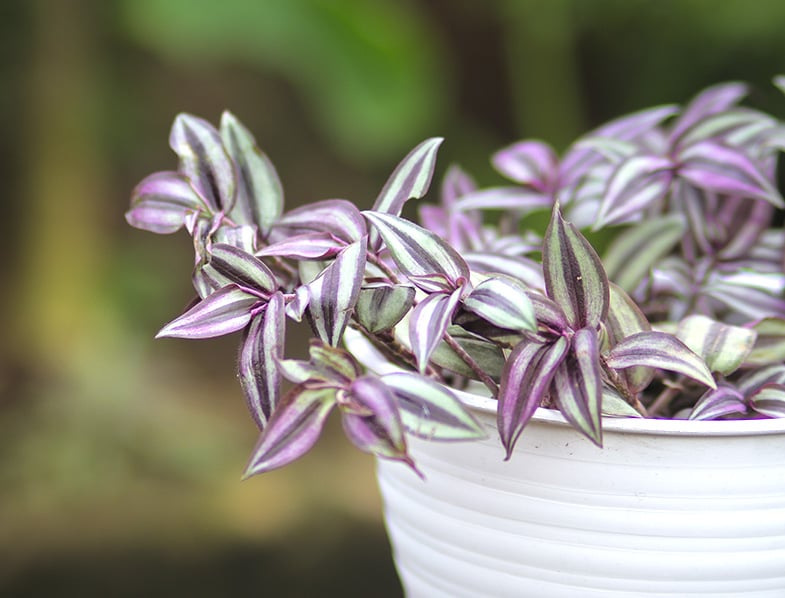
Tradescantia Fluminensis
This wandering Jew species features white flowers, and it’s a trendy indoor plant around the world. The species originates from the southeastern region of Brazil. It’s an evergreen perennial plant that flowers all-year-round and lasts for many years if the owner takes care of it correctly.
The oval-shaped foliage of the Fluminensis is green in color and has a glossy look. The leaves attach to fleshy stems, and the stem nodes quickly put roots down into the soil, allowing for the rapid spread and growth of the plant in ideal growing conditions.
When the plant flowers , it produces a set of flowers with three white petals. The flowers don’t bear any seeds, and they might also emerge in clusters. There are various sub-species of this plant as well, and some types, such as variegate, feature different leaf colors, such as yellow or cream streaks in the leaves.
The plant does best in USDA zones 9 to 12, as it loves the additional humidity in these regions as well. The wandering Jew doesn’t do well in colder climates, so stick to planting in the southern states.
The wandering Jew also prefers full sunlight during the day, and you’ll need to feed it a reasonable amount of water throughout the week. The plant doesn’t enjoy being dry for long periods.
Tradescantia Pallida
This variety originates in Mexico, and it’s the most attractive of the three Tradescantia genus. This wandering Jew produces long, pointy leaves that can reach lengths of 7-inches. The leaf will eventually turn a purple color, but the tips might remain red or green during the color transition.
There are visible segmentations on the stem of this wandering Jew, and it’s for this reason that many countries classify this plant as invasive.
The segments break easily, but they root readily, evolving into two plants with little care. Fortunately, for fans of the plant, it also makes it easy to grow the plants for cuttings as well.
Tradescantia pallida don’t like the cold, and it will die back in colder environments in the Northern states, especially if it grows outside. This wandering Jew produces small flowers that bloom in colors of pink, lavender, and white. The flowers feature three petals, and while they aren’t show-stopping, then do add a beautiful aesthetic to the plant.

- shipped in inproved box to save the plant

Last update on 2024-07-02 / Affiliate links / Images from Amazon Product Advertising API
Natural Air Cleaners
One of the reasons why the wandering Jew is such a popular house plant is its natural air-cleaning properties. The wandering Jew is an excellent “air scrubber,” and it removes bacteria and VOCs from the air inside your home, exchanging it for fresh air that enhances your home.
Some research also shows that the wandering Jew can assist in soil remediation, as well. The plant can remove heavy metals from the soil, helping restore the root health of other plants in the same flowerbed or pot.
Caring for Your Wandering Jew Plant
All varieties of the wandering Jew are easy to care for, provided that you grow them in the right climate and conditions. As long as the plant receives regular watering and pruning, it will thrive, and you’ll also manage to control the growth as well.
If you plant in a sunny spot in your home, then you can expect your tradescantia to last for many seasons. It’s also important to note that the plant might not flower it in its first season. However, by the third year, you should see plenty of flowers that emerge in the summer months.

As mentioned, the wandering Jew prefers sunny planting locations. The plant prefers later afternoon sun to morning sun, but it does well in any sunny area around the home. The more light you give the plant, the more flowers it produces in the flowering season.
If your wandering Jew does not get sufficient sunlight, you’ll notice that the color of the leaves starts to fade. Move the plant to a sunny spot, and it should recover in less than a week.
The wandering Jew enjoys a balanced moisture level in its soil . Don’t let the earth get too dry, as it might cause burning in the tips of the leaves. Likewise, the wandering Jew does not enjoy excessively wet soil either. The plant is susceptible to forming root rot if you “keep its feet wet.”
To check if it’s time to water your wandering Jew, push your finger about 1-inch into the soil. If it feels dry, then give your plant some water.
You must ensure you use a rich, loamy soil that drains well when planting your wandering Jew. When planting in a pot, make sure you add a layer of gravel at the bottom of the pot to enhance drainage. Add perlite to the soil to assist with drainage as well.
You can get away with using a standard potting mix when planting indoors , and other soil enhancements we recommend you add are the following.
- Coarse sand and perlite for drainage
- Humus or peat
- A light dusting of lime
- A few handfuls of rich organic compost
You want the soil to retain water but still allow optimal drainage.
During the growing season, fertilize your wandering Jew plant using a liquid-based fertilizer product. Make sure that you dilute the fertilizer to 50-percent strength.
Strong concentrations can result in burning in the tips of the leaves of the plant. You can also add a granular slow-release fertilizer to the soil once a year at the start of spring.
The wandering Jew grows quickly, and it might take over its pot in one or two seasons, depending on the size of the container. Therefore, you’ll need to pull up the plant and divide it from year-to-year, depending on its growth rate.
If you choose to re-pot your plant, make sure you use a pot that’s at least 50-percent larger than the old one. Line the pot with potting soil and a few handfuls of rich organic compost. Dig around the edges of the existing container to loosen the root ball. After loosening, pull the base of the plant to release it from the pot.
Move the plant to its new pot, and then fill with potting mix to cover the roots — Pat down the soil, and then water lightly.
Wandering Jew plants require regular pruning . The plant grows quickly, and if you don’t prune, then it can overtake the pot fast. Pruning also helps the stem, from getting “leggy,” meaning that the plant starts to look bare at the base. Pruning keeps the plant healthy and growing at an optimal rate.
All; you need to do is prune back any stems and pinch the stem tips. The wandering Jew will then send out two new shoots from the pinched top, helping your plant spread out into a bush-like appearance.
Propagation
The wandering Jew is easy to propagate . This plant grows quickly in a variety of conditions, which is one of the reasons why most countries list it as invasive. You can propagate your cuttings after your pruning session, without much effort.
Remove all of the leaves but the top set after pruning the stem. Place the cutting in another smaller pot with moist potting soil . Leave the container in the sun, and you should find that the cutting roots in a month.
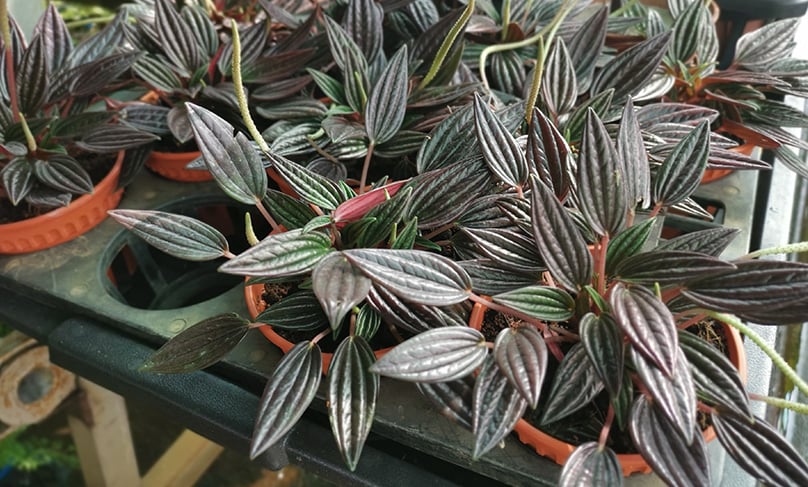
Being an indoor plant , the wandering Jew does not get much attention from pests. However, spider mites can be a problem for your plant if you don’t take care of it and watch for the presence of pests.
Spider mites are tiny spider-like bugs that form a web around the inside of the leaves of the plant. If left unmanaged and untreated, they might start to cause yellow spots in the foliage. The wandering Jew might also fail to flower in the summer months as well.
Over-watering your wandering Jew plant can result in the onset of diseases like root rot. Ensure that you have a well-draining soil mix before planting your wandering Jew. Provided that you do everything you can to ensure your soil drains well, you should never have a problem with root rot in your wandering Jew plant.
Wandering Jew Plants FAQS
What is the best way to grow a wandering jew plant.
The best way to grow a Wandering Jew plant involves placing it in a location that gets plenty of sunlight, preferably late afternoon sun. You should use well-draining, loamy soil to plant it, and ensure a balanced moisture level by watering it regularly but not excessively. The plant also appreciates humidity and occasional fertilizing with a liquid-based fertilizer diluted to 50% strength during the growing season. Pruning should be done regularly to manage its growth.
Is Wandering Jew easy to grow?
A: Yes, Wandering Jew plants are generally easy to grow. They adapt well to various conditions and are fast-growing. They can be propagated easily from cuttings and require minimal maintenance beyond regular watering, pruning, and an occasional application of fertilizer. However, they do not tolerate cold climates very well.
Does wandering Jew like full sun or shade?
Wandering Jew plants prefer locations with full sunlight. They can tolerate some shade but too much shade can cause the color of the leaves to fade. More sunlight exposure generally leads to more flowers during the flowering season.
How often do you water Wandering Jew?
Wandering Jew plants should be watered regularly to maintain a balanced moisture level in the soil. However, the soil should not be allowed to become too dry or too wet. Overwatering can lead to root rot. A good way to check if it’s time to water is to push your finger about 1-inch into the soil. If it feels dry, it’s time to water the plant.
Is Tradescantia Zebrina easy to grow?
Yes, Tradescantia Zebrina, a variety of Wandering Jew, is easy to grow. It requires similar care to other Wandering Jew varieties and is known for its adaptability and quick growth.
Does Tradescantia Zebrina need full sun?
Tradescantia Zebrina does best in a location with full sunlight. While it can tolerate some shade, insufficient sunlight can cause the leaves to lose their vibrant color. Like other Wandering Jew plants, the more light it gets, the more flowers it produces during its flowering season.

Hollie is a life-long gardener, having started helping her Dad work on their yard when she was just 5. Since then she has gone on to develop a passion for growing vegetables & fruit in her garden. She has an affinity with nature and loves to share her knowledge gained over a lifetime with readers online. Hollie has written for a number of publications and is now the resident garden blogger here at GardenBeast. Contact her at [email protected] or follow on twitter https://twitter.com/greenholliec
Pampas Grass Guide: How to Plant & Care for “Cortaderia Selloana”
Rhaphidophora tetrasperma guide: how to grow & care for “mini monstera”, corn plant guide: how to grow & care for “dracaena fragrans”.
under the photo “easy to propagate”, that is not a wandering jew-its a peperomia “rosso!”
My wandering jew plants leafs are getting dried. Why is that?
It’s not getting enough humidity
Could you elaborate on “rich organic compost”? What should it be made of, exactly? Can I use compost accelerator in the soil mix?
Worm castings are great, or worm tea, egg shell tea is another.
What month does the jew break ground to start growing?
All depends on your specific areas weather pattern and seasons.
Do NOT BUY ANY OF THIS SPECIES if you have a dog because dogs are very allergic to these plants & come out in bad rashes if they wander through them!
Leave A Reply Cancel Reply
Save my name, email, and website in this browser for the next time I comment.
Type above and press Enter to search. Press Esc to cancel.

Wandering Jew Plant (Tradescantia zebrina): Types, How to Grow and Care
Sharing is caring!
Plants with trailing and creeping habits are some of the best plants to keep. They are fast-growing and make thick carpet of groundcovers for gardens in no time and they also create striking hanging indoor plants.
Among the all-time best trailers to grow is the wandering jew. Easy to maintain and drapes beautifully, this colored plant will make any space more inviting and interesting.
Medicinal Properties
Propagation and maintenance, what is a wandering jew plant.
Tradescantia is one of the 37 genera under the plant family Commelinaceae (1). Some of its 75 species are commonly called ‘wandering jew’ (also known as inch plant), a name they adapted due to their long lifespan like the Jewish character from a Christian folklore.
Another name for this group of herbaceous perennial plants is ‘spiderwort’ after the spiderweb-like sap they produce when the stem breaks. They are native to Canada, Mexico, and Argentina and have been naturalized in other parts of the world (2).
The most common tradescantia grown ornamentally is the T. zebrina also previously called Zebrina pendula . It has long fleshy stems where the wandering jew plant leaves and roots appear. The lance-like leaves are a mixture of green and purple with silver stripes on the upper side and deep purple under (3). The plant grows close to the ground and can only reach 20 to 30 cm high.
Does Tradescantia Zebrina Flower?
The wandering jew is considered an ornamental plant primarily because of its showy colorful foliage but the plant does produce pink flowers.
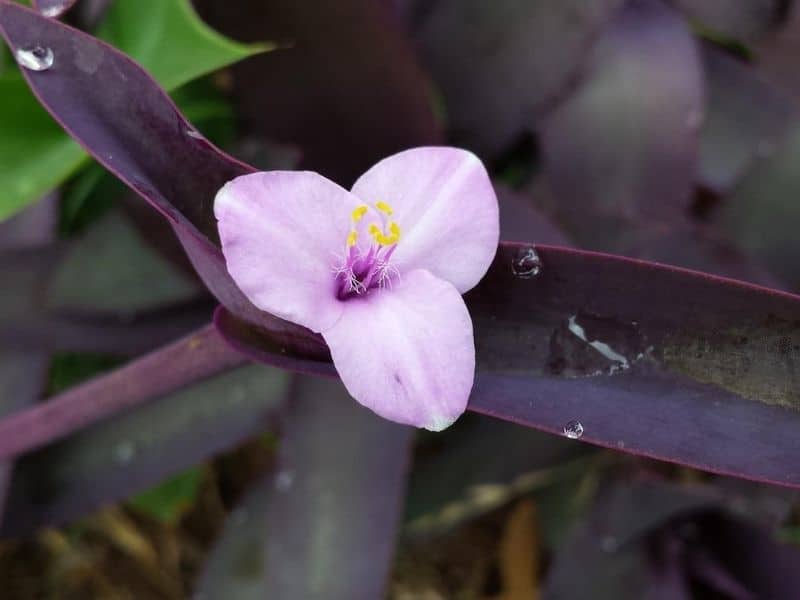
Small three-petaled pinkish purple flowers appear sporadically throughout the year (4). The resulting fruit is a capsule containing tiny brown seeds.
Is it Toxic to Pets?
Spiderworts are normally harmless plants but they contain toxic properties that may cause mild gastric problems and dermatitis to pets. Although they don’t lead to anything serious, it will be safe to keep the plants out of reach of pets and to keep the hands protected when dealing with the sap of the plant.
Because of the plant’s hardiness and adaptability to different environments, the wandering jew establishes well, in fact so well that it can be considered an invasive species. In countries like Australia, the plant has the capacity to invade natural vegetation. Although growing them is not prohibited, everyone is obliged to keep the plant’s growth under control (5).
Studies showed that Tradescantia has significant effects as an anticancer, antioxidant, and antibacterial medicinal plant. In traditional Chinese medicine, the wandering jew plant is highly valued as treatment for kidney failure.
The extract from the whole plant is cooked with dates, ginger, and water and consumed by patients. The plant is also known to treat high blood pressure, cough, urinary tract infection and tuberculosis (1).
How to Grow and Care for a Tradescantia
Here’s how to care for a wandering jew plant, one of the easy house plants to own.
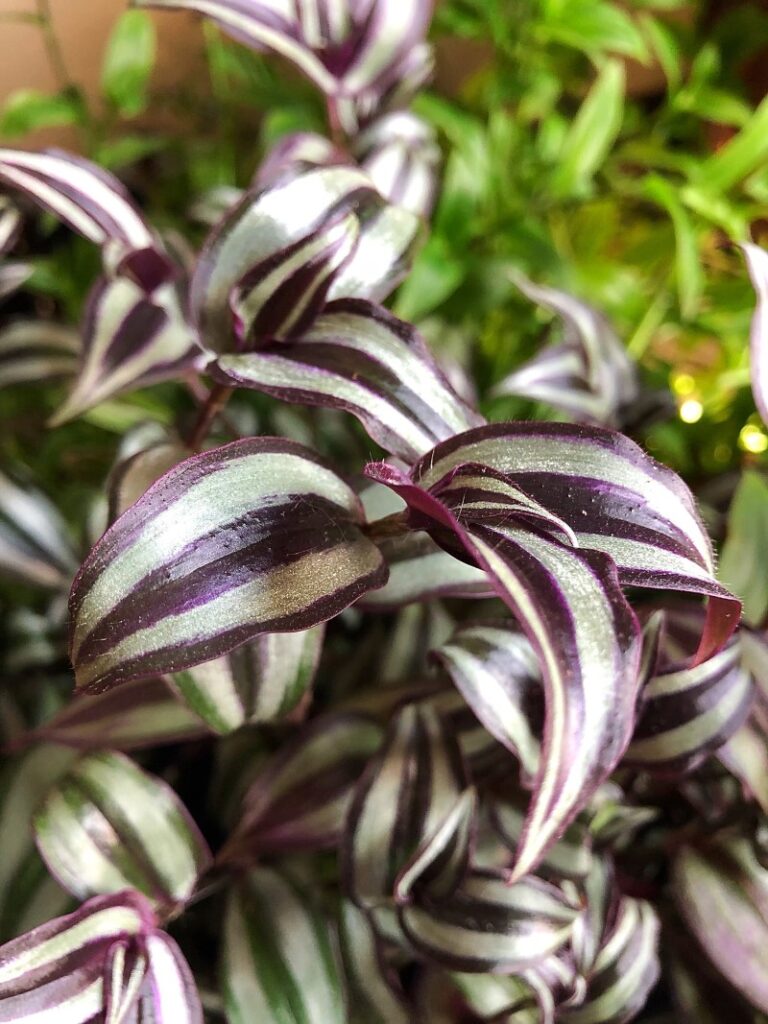
Light and Water
In the wild, the wandering jew plant thrives without assistance but under the right conditions. It likes filtered sun so indoor fluorescent light is enough. Placing them by the window and turning the plant every two weeks will keep the leaves colorful and the growth even on all sides (3).
The plant spreads easily in damp areas that’s why it naturally grows along riverbanks and roadsides. When potted, the soil should be kept moist but well-drained. Saturated soil often causes root rot.
Fertilize your Tradescantia plant once a month during the growing season (spring and summer) with a balanced, water-soluble fertilizer diluted to half strength. Avoid fertilizing in fall and winter when the plant is dormant. Over-fertilizing can lead to fertilizer burn and damage the plant, so follow the instructions on the fertilizer package carefully.
Temperature and Humidity
Spiderworts like it warm but there should be enough air circulation or else the leaves will sag. During the heat of the summer, taking the plant outside under shade will provide the necessary cool to the plant.
Mist the hanging plant early in the morning and late in the afternoon. If the plant is on a table, place a glass of water beneath the leaves or put the pot on a wet pebble tray. This will humidify the immediate vicinity of the plant aiding in its photosynthesis and transpiration processes.
Pests and Diseases
The most common living enemies of the wandering jew are aphids, mealybugs, scale, white flies, and spider mites. Manual removal at the onset of infestation is effective but they should be closely monitored as serious attack may lead to the plant’s death. If left unnoticed and the infestation has become severe, get rid of the plant by burning to avoid contamination.
Since the creeping inch plant is mainly soft almost like a succulent, soggy soil and too wet conditions lead to root and stem rot (4). As long as the plant is receiving just enough moisture, this disease will be avoided.
Propagating wandering jew plants is very easy. They can grow from seeds but will take years to establish so the more convenient stem cutting is best. The trailing or creeping stems form nodules where the roots will eventually grow as it comes in contact with the potting soil (2). When the hanging plant has longer trails than intended, it can be trimmed and the resulting stem cuttings can be rooted to form new plants.
There will be times that the potted wandering jew will become leggy, especially if it’s been receiving more shade. To promote a bushier growth pinch back by literally pinching the tip of the plant where the new growth occurs (4). This practice allows the formation of lateral stems.
In two or three years, these hardy plants may become pot bound, with the roots taking up most of the space in the pot. Repot in a larger container with a good mixture of soil, coarse sand, and compost to replenish the nutrients and provide room for the roots to breathe. Additionally, fertilize once every two months by foliar application just to improve plant vigor.
Common Varieties of Wandering Jew
The oldest and most common indoor wandering jew, this species has leaves alternating, often overlapping when young, purple leaves with silvery green thick stripes and solid purple underside. The stem is also a mixture of purple and green.
T. blossfeldiana
The leaves of this species are quite thicker, glossy, and covered in miniscule hairs called trichomes. The three-petalled flower is an ombre of white and pinkish purple with yellow anthers.

T. fluminensis ‘Tricolor’
This attractive variety showcases leaves with white, lilac, and green variegation. It appears smaller than the common wandering jew but bushier in form.
T. sillamontana
This whimsical species looks frosted with its silvery trichomes covering the entire plant. The green leaves are still alternately arranged but more compact which make a potted plant look more bushy than trailing. The light color of the leaves provide a complementing backdrop to the bright purple flowers.
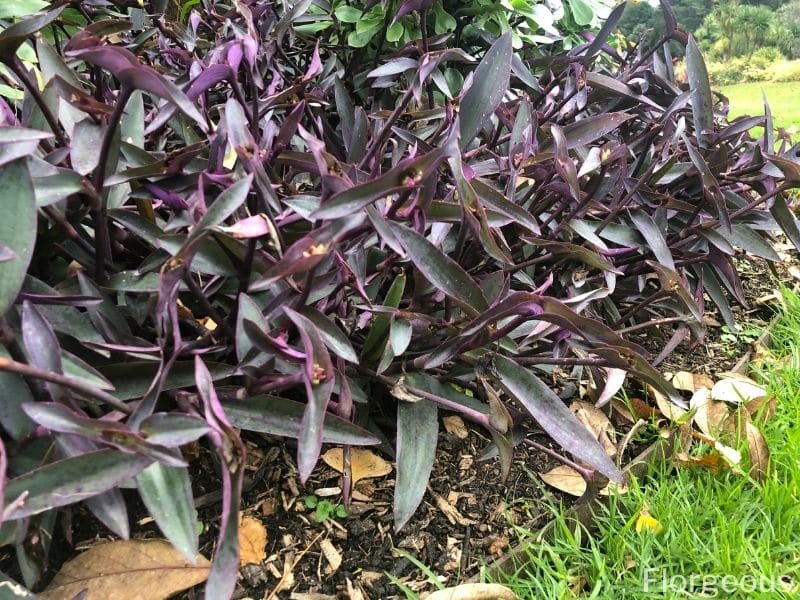
The leaves and stems of this species are in striking deep purple color hence the common name ‘ purple heart ’. Under shaded, they turn a hint of dull green. The leaves are also longer and have wider space in between.
Does Wandering Jew plant need full sun?
Wandering Jew plants (Tradescantia zebrina) prefer bright indirect light but can tolerate some direct sun, especially in the morning or late afternoon. However, prolonged exposure to intense sunlight may cause their dark green leaves to scorch.
How do you care for a wandering Jew plant indoors?
To care for a Wandering Jew plant indoors, place it in a location with bright, indirect sunlight, such as near a window. Water it when the top inch of soil feels dry, typically every 1-2 weeks, and provide well-draining soil. Additionally, mist the plant occasionally to increase humidity and remove dust from the leaves.
How do I make my Wandering Jew fuller?
To make your Wandering Jew plant fuller, prune it regularly to encourage branching and bushier growth. Pinch off the tips of the stems or trim back leggy growth to promote new growth and create a more compact appearance. You can also propagate wandering jew cuttings to create new plants and fill out the pot.
How long do Wandering Jew plants live?
Wandering Jew plants are generally long-lived when provided with proper care. With the right growing conditions indoors, they can thrive for several years, often becoming fuller and more lush over time with regular pruning and maintenance.
Reference List
(1) Dash, G., et. al. Tradescantia zebrina: A Promising Medicinal Plant. 2017. IAJPS, 4 (10). P. 3498-3502 .
(2) Arakelyan, H. Tradescantia zebrina- Mother Nature Healing. 2019. Researchgate.
(3) Vermeulen, N. Encyclopedia of House Plants. Taylor and Francis. 1999. P. 320.
(4) North Carolina State Extension. Tradescantia zebrina. NC State University. 2018. https://plants.ces.ncsu.edu/plants/tradescantia-zebrina/ . Accessed on 12 August 2020.
(5) The State of Queensland. IPA-Zebrina. Department of Agriculture and Fisheries. 2020. https://www.daf.qld.gov.au/__data/assets/pdf_file/0020/51284/IPA-Zebrina-PP102.pdf . Accesed on 12 August 2020.
Photo by Wirestock/depositphotos
Have you seen these?

Overwatered Lantana: Identifying, Fixing, and Preventing Water Damage

Overwatered Petunias: Signs, Damages, and Recovery Steps

Overwatered Pumpkin Plant: A Comprehensive Guide to Rescue and Prevention

Overwatered Dogwood Tree: Causes, Symptoms, and Revival Techniques

Overwatered Lavender: A Comprehensive Guide to Prevention and Recovery

Overwatered Geraniums: Comprehensive Guide to Causes, Signs, and Recovery Strategies
About the author.
Wandering Jew (Tradescantia Genus) Care & Growing Guide
The Wandering Jew is a name that is used for several different species of plants in the Tradescantia genus, which includes at least 75 different species.
In times past, gardeners would share cuttings from their Wandering Jew plants with friends and neighbors so, like its name, it traveled from place to place. If you want to brighten up your home, having the Wandering Jew Plant will do just that with its colorful variegated foliage and beautiful flowers .
Wandering Jew Care & Growing Guide
1. light requirement.
They will tolerate low light as this will help them to retain their striking colors. If it is an indoor plant, put it in a location where it will receive filtered sunlight. Outdoors, it needs to be in a spot where it is receiving partial shade or partial sun. You can also move your indoor plant outside to get this type of shade or sun.
The soil will need to be kept moist but not soggy. If the soil starts to feel very dry, then it is time to water your plant. Just stick your finger into the soil and if the top inch feels dry, water it until the water comes from the bottom of the drain holes of your plant.
For the outdoor plants, during the spring-summer growing season, you should water your plants once a week. In the winter, during the dormancy period, you will only need to water it about once every other week. It will need to be fertilized each month during the growing season.
The Wandering Jew can be grown as a houseplant in any climate but outdoors it should be USDA Hardiness Zone 9-12
The Wandering Jew plant can grow in different soils as long as they drain well in order to prevent stem and root rot. You should make sure that you are using a lightweight soil mixture. You should not use straight potting soil as they retain too much moisture. You can also use a potting soil that has a slow-release fertilizer mixed in so you do not have to fertilize each month.
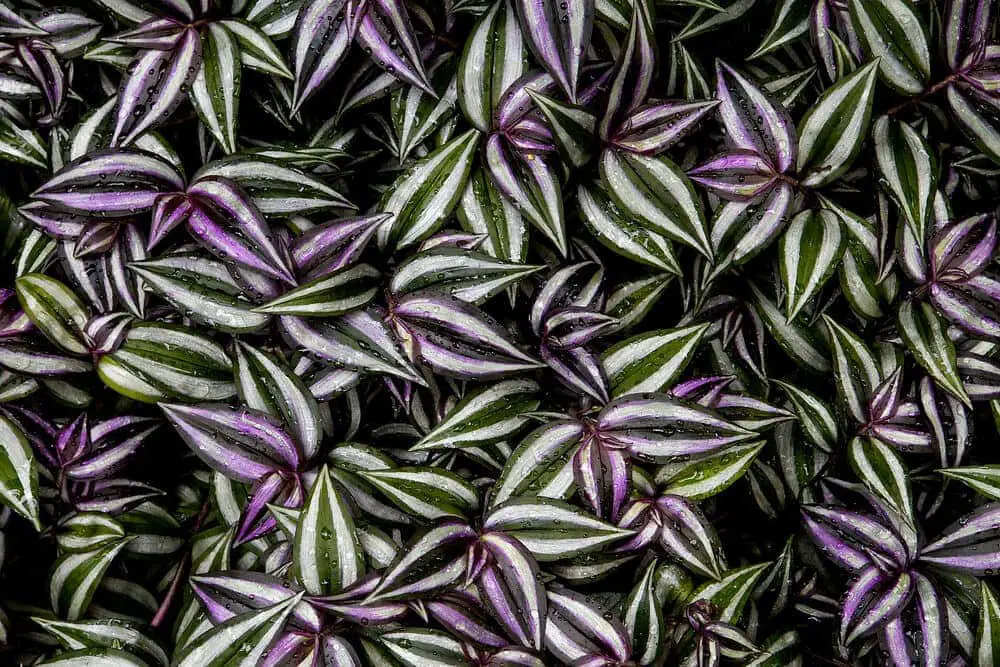
5. Temperature
The ideal indoor temperature should be between 50-85 degrees Fahrenheit. They do need some humidity for growing so if your house is not very humid, you can fill a spray bottle with water that is at room temperature and mist the plant several times a week.
6. Repotting
If you bought a Wandering Jew that is already in a planter or container, it should be okay for at least a year before it needs to be repotted. If you get root cuttings in a small four to six-inch pot, you will probably have to repot the plant into something bigger or outside so they can properly grow. In that small of a pot, it will outgrow it in a month or two.
7. Speed of Growth
It is stated that it has a fast rate of growth and will quickly spill over your hanging basket or covering your ground area. When you are starting new plants from your cuttings, it will take several weeks before you start to see new roots.
8. Height and Spread
The stems of the Wandering Jew plant grow from 6-9 inches high and 12-24 inches in spread
Depending on the species, you can get pink, white, or rose-purple blooms
10. Trimming
The Wandering Jew does not need much trimming. You can pinch off the stems if you want to promote a bushier growth or control the size of the plant. Trim off any dead, damaged, or broken leave or stems throughout the year to keep it looking good. You should regularly pinch the stems back by at least twenty-five percent.
Is Wandering Jew Poisonous?
Some people may experience skin irritations when they handle the cuttings because of the sap so you may need to wear gloves when you work with the plant. If your pet chews on it, the sap can irritate their digestive system, especially a cat. If they eat or chew on the leaves, these do not normally cause a problem, just the stems with the sap.
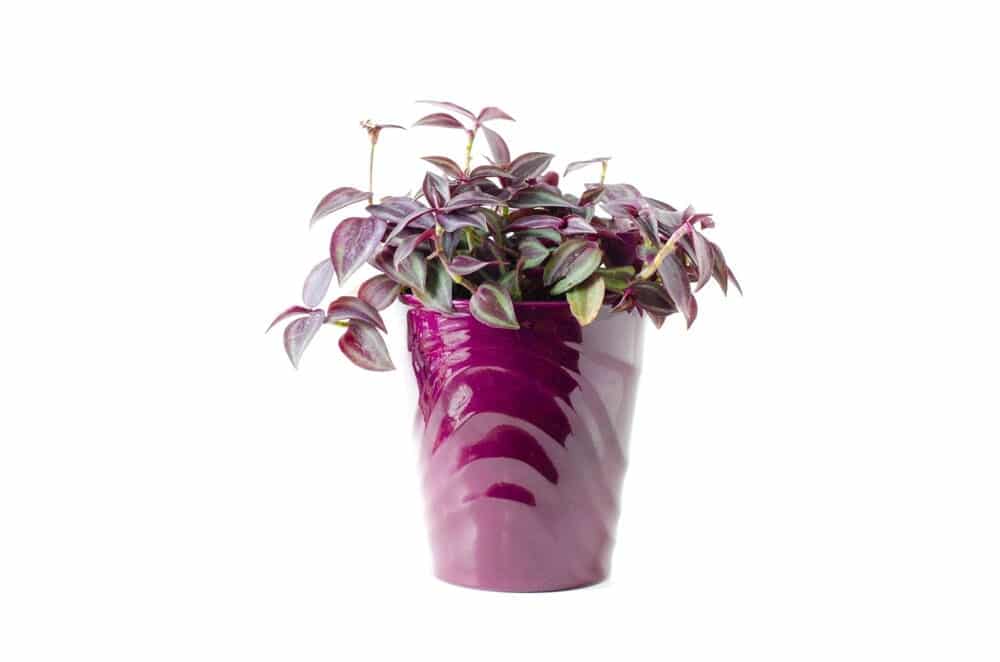
Can Wandering Jew grow in Water?
Yes, you can take the cuttings from your trimming to start new Wandering Jew plants in water. Fill the container with three inches of water that is room temperature. Pinch off any of the leaves that will be submerged in water before you put the cutting in the container. Set it in a bright indoor location. Change the water when it becomes cloudy or every other week. When the roots are several inches long, you can repot them in a planter or outdoors.
How to get Wandering Jew to Flower?
Make sure that you give it the right soil, and moisture. Also remove any dead flowers or dead or damaged leaves. You also want to make sure it is getting the right light because the brighter the light, the more flowers it will produce.
More like this: Elephant Bush (Portulacaria Afra) Care & Growing Guide
Common Plant Diseases
Wandering Jew is prone to a variety of diseases, including:
- Stem or root rot—it is getting too much water or it is not draining properly so watch the watering and make sure that it is draining.
- Leaves losing color or drooping—not enough light so if indoors, you just have to move the plant where it will get more light.
- Sunburned foliage—too much sun so you need to put it in a less sunny location.
- Aphids, spider mites, mealybugs, or whiteflies—these are all sap-sucking insects and can quickly kill your Wandering Jew plant. If the infestation is small you can just wipe the leaves and get rid of them. You may also use an insecticidal soap with water and gently spray the plant.
- Rubber plant Care & Growing Guide
- Amazon Lily Care & Growing guide
- This is a hardy plant that is easy to take care of, even those that fell they kill every plant they try to grow.
- They grow well outdoors in frost-free regions or in hanging baskets or planter.
- When grown outdoors, it can be used as a groundcover that grows quickly.
- The biggest problem with using Wandering Jew as a houseplant is to be able to get the moisture levels correct.
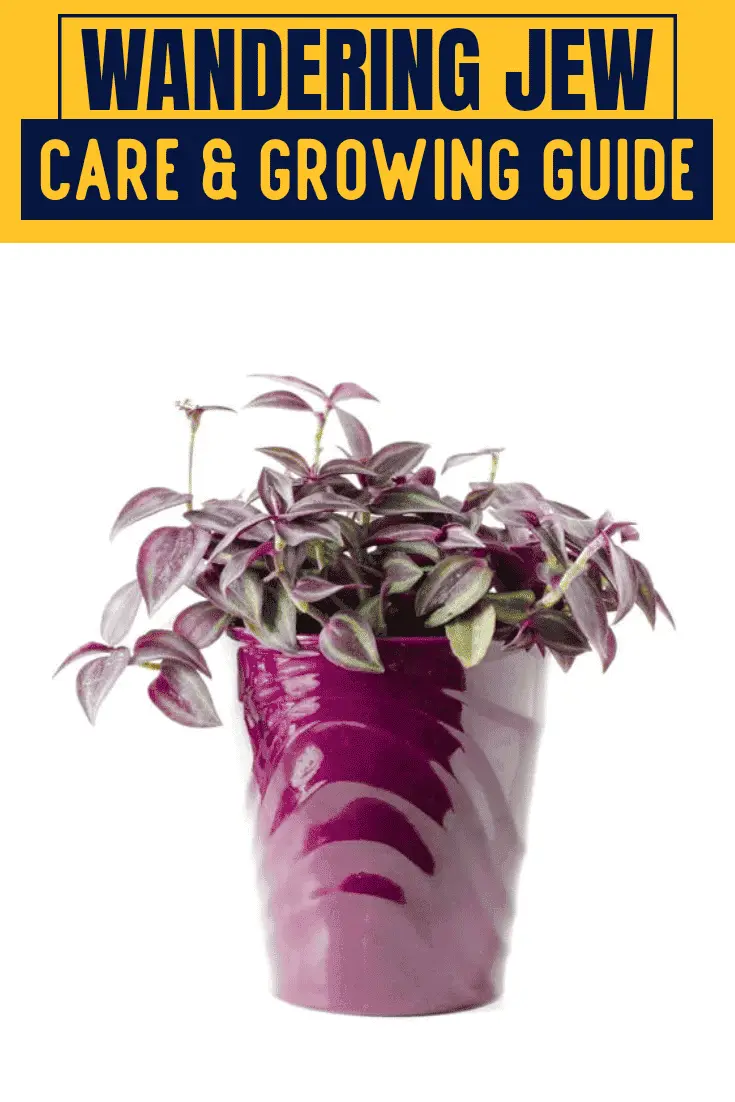
Victoria is the owner and main author of hobby plants. She loves spending her free time in her garden planting and taking care of her plants. Victoria hopes you enjoy the content here!

Related Posts:
![How To Propagate Wandering Jew? [COMPLETE BEGINNER'S GUIDE] How To Propagate Wandering Jew? [COMPLETE BEGINNER'S GUIDE]](https://www.hobbyplants.com/wp-content/uploads/2022/07/how-to-propagate-wandering-jew-300x158.jpg)

Wandering Jew (Tradescantia zebrina): Plant Care and Growing Guide – House Plants Expert
Table of Contents
The Wandering Jew plant is the common name given to a number of plants from the Tradescantia genus, including the scientific name Tradescantia Fluminensis, Tradescantia Pallida, and the most popular one – Tradescanita Zabrina.
The common name of “The Wandering Jew” is believed to come from a legend that the wandering jew ‘taunted Jesus’ en route to being crucified and was cursed to walk the Earth until the second coming. This can be viewed as antisemitic to some so be sensitive to that. We love our plants and certainly do not mean to offend when using their common name. Many have started now to use the common name wandering dudes or dude plant.
Some countries classify this species as an invasive plant or even a weed. This is because of its growth habit (it grows fast and prevents the growth of other plants). However, grown indoors it makes an attractive hanging basket or windowsill plant.
The purple wandering jew or purple heart is one of my favorite plants. The foliage is fleshy, has violet leaf colors, easy to care for, has simple propagation, and is just an overall nice houseplant to have in your collection.
Description
There are a number of tradescantia plants very similar in looks, how they’re grown and their growth habit, including the T. zebrina (which has dark green leaves with silver bands), the Tradescantia Fluminensis variegata with cream stripes, and quicksilver which has white stripes. Then there’s the T. Pallida from the same genus which is sometimes named Wandering Jew plant but looks very different from the Tradescantia Fluminensis and Zebrina.
Foliage
Fleshy oval or lance-shaped leaves are produced from the pendant stems (growing a couple of feet or so long). These small leaves have a shiny appearance and grow to about 2 – 4 inches long with pointed tips. The underside of a leaf is purple in color on the zebrina and new leaves appear purple at first, then turn green. In the wild or grown in gardens (grown as a bedding plant) stems take root at the nodes, but indoors in a hanging basket or container they grow and hang over the sides.
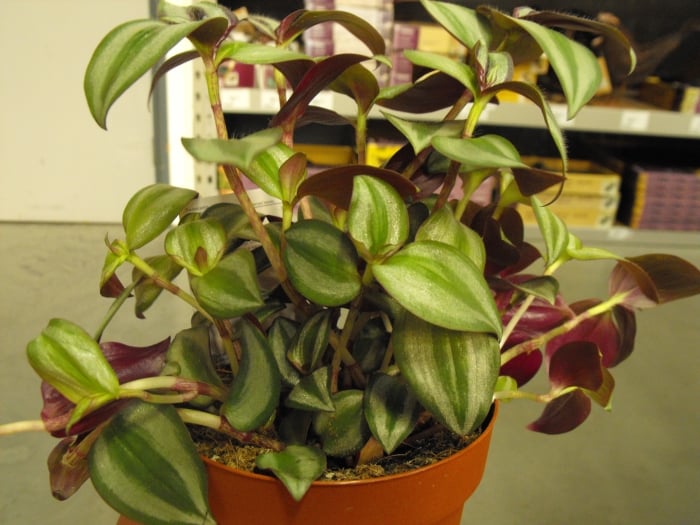
Flowering
The small non-showy flowers are white in color, appearing during summer usually and at other times (depending on the conditions). These flowers appear in clusters and display three small petals.
Plant Care and Growing
Wandering jew plants are pretty simple to care for and maintain, although providing plenty of bright light is important. Tradescantia naturally becomes spindly and needs to be pruned regularly and pinching stems will encourage fuller growth, improving its appearance.
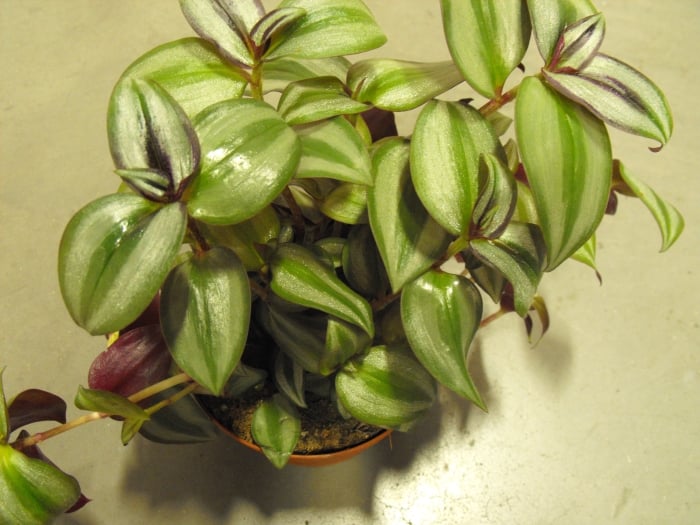
Potential Problems
- Spindly growth and bare stems: This happens naturally with age for this plant but lack of light, water, or plant food can also cause spindly growth. If the plant is old and conditions are fine (water, light, etc.) then it could be time to replace it.
- All green leaves: Variegated leaves turning green and losing their variegation is most likely due to too much light.
- Limp stems: Limp stems are usually a sign that the plant is lacking water
Take a 3 to 5-inch softwood cutting and place it in a moist potting mixture or water. Wait three weeks and enjoy.
Yes, the wandering jew can live in water indefinitely given nutrients and frequent water changes.
Yes, it is toxic but not fatal to cats, dogs, and horses. The leaves contain calcium oxalate crystals which is the toxic component.
The answer is it can be planted inside or out and is even considered a noxious weed in some areas as it grows so well.
Water often to keep the soil moist but not soaked.
Was this helpful?

Elyssa Goins is an experienced house plant hobbyist who maintains over a hundred plants. She is a gardener, beekeeper, and a proud mother of four. She is a member of the American Horticultural Society, has a published study in the National Social Science Association , and loves to talk about her love of plants. For the past twenty years, she’s been all about growing and caring for various fruits, veggies, herbs, livestock, kids, and houseplants. Managing a big garden to feed four growing kids and raising dairy goats has taught her so much about being an excellent plant parent and now is her time to share with you.
Dumb Cane Plant (Dieffenbachia): Plant Care and Growing Guide – House Plants Expert
Monstera albo (monstera deliciosa): plant care and growing guide – house plants expert.
This site uses Akismet to reduce spam. Learn how your comment data is processed .
Hi Mary, I hope you are able settle an argument between my brother & I He claims that golden canes are a grass spieces & not a tree!! Thank you in anticipation James

Oh boy, this feels like a setup. Golden Canes are a monocots which is in the same primary class as grass. What is the definition of a tree? If your hammock is tied to a tree on a tropical island would you call it grass? The technical and practical definitions are not the same for this age old debate.
- Privacy Policy
Copyright © 2013-2024 · Houseplantsexpert.com Houseplantsexpert.com is a participant in the Amazon Services LLC Associates Program, an affiliate advertising program designed to provide a means for sites to earn advertising fees by advertising and linking to Amazon.com.*Amazon and the Amazon logo are trademarks of Amazon.com, Inc., or its affiliates. Additionally, Houseplantsexpert.com participates in various other affiliate programs, and we sometimes get a commission through purchases made through our links.

7 Things Everyone with a Tradescantia (Wandering Dude) Should Know
If you’re looking to add a splash of color and variety to your indoor garden, Tradescantia, commonly known as Wandering Dude, is an excellent choice.
This vibrant plant, native to the Americas, offers a range of stunning foliage options —from shimmering leaves to deep emeralds paired with burgundy undersides, and even silvery stripes.
Whether you’re drawn to its tiny delicate leaves or its large, cascading stems, there’s a Tradescantia variety for every plant lover .
However, before you bring one home, here are seven essential things to know about this versatile and hardy houseplant.
1. A Resilient and Hard-to-Kill Houseplant
One of the standout features of Tradescantia is its resilience. This plant is virtually unkillable, making it an ideal choice for both novice gardeners and those with a less-than-consistent care routine.
Tradescantia’s ability to thrive in various conditions has even earned it a spot on several invasive species lists. However, this adaptability is precisely what makes it such a fantastic houseplant.
Whether you travel frequently or occasionally forget to water your plants, Tradescantia will likely forgive your neglect and continue to thrive .
These hardy plants can bounce back from neglect, making them perfect for anyone who may not have a green thumb. They’re adaptable to different environments, and they can be kept compact or allowed to grow bushy and large.
In terms of care, Tradescantia isn’t picky about soil as long as it’s well-draining. Overwatering is the main thing to avoid, as it can lead to root rot .
Even if you miss a few care steps, your Tradescantia is likely to survive and thrive.
2. Growing New Plants is a Breeze
Tradescantia is incredibly easy to propagate, which is part of why it grows so prolifically. This plant can root wherever a node touches the soil , making it simple to create new plants.
You don’t even need to start with water propagation; just place a stem in a pot of moist soil, ensuring that the leaf node is beneath the surface.
If your existing Tradescantia is looking a bit sparse, you can easily rejuvenate it. Lay one of the trailing stems across the surface of the soil, and wherever there is a leaf node, it will take root and begin to grow new stems.
Within a few weeks, you’ll have a fuller, healthier plant. Propagating Tradescantia is not only easy but also a great way to share this beautiful plant with friends.
3. Tradescantia Can Help Root Other Plants
Thanks to the natural rooting hormones found in its stems, Tradescantia can also assist in propagating other plants . If you’re trying to root a plant that’s a bit more difficult to propagate, Tradescantia can give it a helpful boost.
Simply snip a Tradescantia stem and squeeze some of its juices onto the cut stem of the plant you’re trying to root. If you’re propagating in water, you can also squeeze the juices into the water to encourage root growth.
This method is particularly useful for plants that require extra encouragement to develop roots. By using Tradescantia as a natural rooting hormone, you can increase the chances of successful propagation, making it a valuable ally in your indoor gardening efforts.
4. From Wandering Jew to Wandering Dude
Until recently, several species of Tradescantia were commonly referred to as “ Wandering Jew .” While this name might seem harmless at first glance, it actually has problematic origins.
The name is derived from a medieval Christian legend about a Jewish man who was cursed to wander the earth for mocking Jesus on his way to the crucifixion .
Over time, this story has been used to promote antisemitism, making the name deeply offensive to many. In light of this, the plant has been given a more inclusive and modern name: Wandering Dude .
This name not only sheds the negative connotations of the old name but also feels more fitting for a plant that’s known for its ability to thrive and adapt to various environments.
5. Tradescantia’s Fairy-Like Flowers
While Tradescantia is primarily grown for its striking foliage, it also produces small, three-petaled flowers in shades of blue, purple, pink, and white.
These flowers typically bloom for just one day , but when multiple blooms appear at once, they create beautiful splashes of color against the plant’s rich green leaves.
To encourage flowering, make sure your Tradescantia gets plenty of bright, indirect light. Using a fertilizer designed for African violets can also provide the necessary nutrients for blossom development.
Keep the soil consistently moist but not soggy , and with a little patience, you may see buds forming, especially after a period of dormancy during the fall and winter.
It’s important to note that not all Tradescantia species are prolific bloomers. However, varieties like Tradescantia pallida and Tradescantia multiflora are more likely to produce flowers, so if blooms are important to you, consider choosing one of these species.
6. Keeping Those Vibrant Leaves
One of the most common issues Tradescantia owners encounter is fading or discolored leaves. The vibrant colors that make this plant so appealing are highly dependent on light.
Tradescantia needs plenty of bright, indirect light to maintain its vibrant colors. If your plant isn’t getting enough light, its leaves may lose their intensity and become washed out.
On the flip side, too much direct sunlight can also cause problems . Prolonged exposure to direct sun can lead to leaf scorch, where the leaves may fade or develop sunburn spots.
To keep your Tradescantia looking its best, find a spot with plenty of filtered sunlight or provide shade during the hottest parts of the day.
7. The Many Faces of Tradescantia
One of the most exciting aspects of growing Tradescantia is the sheer variety of species available. With over 75 species to choose from, there’s a Tradescantia to suit every taste .
Popular houseplant varieties include Tradescantia zebrina, known for its distinctive striped leaves, and Tradescantia pallida, often grown outdoors in warmer climates.
For those who prefer something a bit more delicate, the Tahitian bridal veil with its tiny emerald leaves and delicate stems is a personal favorite.
And for those who love plants with unique textures, Tradescantia sillamontana offers soft, fuzzy leaves that are almost irresistible to touch .
In conclusion, no matter which Tradescantia variety you choose, you’re sure to enjoy the beauty and resilience this plant brings to your home.
With its easy care, vibrant colors, and fascinating history, Tradescantia is a plant that truly has something for everyone.
I'm Rita, passionate about flowers, plants and growing my own vegetables at home. I live in an apartment, but I still have my garden, I intend to use all my knowledge to help you also have a lively, happy and productive garden (even in an apartment).
Similar Posts
Monstera’s Leaves Curling? Here’s How To Revive Them!
It can be quite disheartening to see your monstera leaves curling. You instantly go into panic mode and try to fix the issue by overwatering the plant because everyone said it’s too dry. Well, believe it or not, dryness may not be the only issue here… In this article, we’ll go over 4 of the…
7 Best Indoor Plants For Low Light Bedrooms
Do you live in a house that just doesn’t let sunlight get to your room whatsoever? Well, that’s unfortunate – you’re missing out on a lot of essential vitamin D and can’t even keep plants in your bedroom. But, wait, is the latter part really true? We all know that sunlight is essential to plants…
Top Perennials for an Easy-Care Garden in the US
Who doesn’t dream of a garden that practically takes care of itself? We all want a landscape that looks stunning with minimal effort, especially when life gets busy. The secret to a low-maintenance, beautiful garden? Perennials! These plants come back year after year, offering an evolving display of color, texture, and form. The best part?…
13 Air Purifying Indoor Plants (Pet Safe!)
Air-purifying plants are the perfect example of killing two birds with one stone. I mean… They beautify your surroundings and purify the air you breathe in? Sounds like a pretty good deal to me! Even though all plants absorb carbon dioxide and let out fresh oxygen for us to breathe, there are some that do…
9 Best Plants For Christmas Gifts (With Images)
People today are so obsessed with the latest technology and Amazon gift cards that a simple gift of something like plants are considered small or “strange”. But, let’s not make that the norm; plants and flowers as Christmas gifts should be the norm. Thankfully, this is actually a normal thing in my family. I love…
9 Beautiful Houseplants Safe For Cats & Dogs
When considering which houseplants to get, regular people are almost always chill because all they need to worry about is the free space in their house. Pet owners, however, have nothing easy when it comes to bringing something home. Questions like “Will this be safe for my dog?”, “What if my cat chews on it?”…
Leave a Reply Cancel reply
Your email address will not be published. Required fields are marked *
Save my name, email, and website in this browser for the next time I comment.

- Indoor Gardening
- Houseplants
- Hydroponics
- Houseplants Made Easy Book

How To Care For A Wandering Jew Plant (Your Complete Guide)
When it comes to houseplants able to brighten up indoor spaces, it doesn’t get much more colorful than the variegated foliage of a Wandering Jew plant ( Tradescantia zebrina ). With their hardy nature and ease of care, they are a perfect choice for those feeling they kill everything they bring indoors. We’ve listed a quick summary of their care below.
How To Care For A Wandering Jew Plant: Grow your Wandering Jew in well-drained soil, kept moist but not soggy through regular watering. Create humidity, keep indoor temperatures between 50°F (10°C) to 85°F (29°C) and fertilize monthly.
Continue reading because we’ve taken all the guesswork out of caring for your Wandering Jew and keeping it healthy and happy for years to come.
How To Care For A Wandering Jew Plant
Wandering Jew plants belong in the Commelinaceae family, which includes around 652 different species. The family is made up of herbs, climbers and several epiphytes, with some used as outdoor and indoor ornamentals like Wandering Jew.
There are three different plants commonly known as Wandering Jews; Tradescantia fluminensis , Tradescantia pallida , and Tradescantia zebrina. Of the three, Tradescantia zebrina is the most common one grown and has the most eye-catching and colorful foliage. All three have the same requirements for care and good growth.
Native to Mexico and Guatemala, Wandering Jew is classified as a tender evergreen perennial that performs well planted outdoors in frost-free regions. Those living in cooler environments can easily grow it as an indoor plant planted either in containers or in hanging baskets. Outdoors it’s typically used as a quick-growing groundcover.
Although a common name shared with several very different plants, Wandering Jew is often called Inch Plant , due to the leaf margins being spaced about an inch apart. You may also find Wandering Jew listed as Zebrina Pendula , but is synonymous with Tradescantia zebrina and is the same plant.

When it comes to Wandering Jew plants, it’s all about the attention-grabbing foliage. The succulent stems give way to leaves that are a deep purple on their undersides with the upper portion striped in silvery-gray and greenish-blue. The oval leaves grow to about 2.5 inches long and the stems grow about 2 feet long. It makes a beautiful plant used in hanging baskets, with the long stems cascading over the side.
Even grown indoors, Wandering Jews have a fast rate of growth and before you know it, the plants will be spilling over your container’s or hanging basket’s sides. Whereas some indoor plants seem to take forever to fill out, this isn’t a problem with properly cared for Wandering Jew plants.
There are several other cultivars (varieties) of Wandering Jew, which include:
- ‘Purpusii’ has unstriped, hairy foliage that is either solid red or reddish-green.
- ‘Quadricolor’ produces metallic-green foliage striped in red, white and green.
Wandering Jew plants are the ideal candidates for beginner houseplant gardeners due to their hardiness and robust growth. Below we’ve outlined all the basics of their proper care, as well as identifying and preventing any potential problems so you can enjoy your Wandering Jew for years to come. The best indoor plants are those that are happy and healthy.

Soil Conditions For Wandering Jew Plants
Wandering Jew plants tolerate growing in a wide range of soils provided they drain well. Although they do tolerate and prefer moist conditions, the soil must drain properly to prevent root and stem rot from occurring. Therefore, it is necessary to use a lighter weight soil mixture in your pots rather than heavier soils that don’t provide proper drainage.
Straight potting soils are usually too heavy, retain too much moisture and have a tendency to leave the soil soggy. You can use a heavier potting soil in your soil mixture, just be sure to incorporate a lighter soil mix to provide the Wandering Jew the drainage required for healthy growth.
Commercial potting mixes work well and many have a slow-release fertilizer mixed in, which cuts down on the need for frequent feedings. The slow-release blends usually continue to fertilize the Wandering Jew for about three months.
You can also make your own soil by mixing several ingredients together such as:
- Using equal parts of compost and a potting mix.
- Mixing equal portions of compost, peat and potting soil or a potting mix.
- Using equal portions of a course sand, compost and potting soil or a potting mix.
Whatever soil you choose to use, just make sure it drains well and contains a bit of fertility for the best performance of your Wandering Jew plants.
Preferred Light Conditions
Although Wandering Jew plants tolerate lower light conditions than many houseplants, to help retain those striking colors the plant is known for, place the container in a location indoors receiving filtered sunlight. If your plant starts losing some of the color in the foliage, move it to a location that receives a bit more light.
In addition, if the lower portion of the stems start suffering leaf drop, the Wandering Jew isn’t get enough light and needs to be relocated to a brighter area inside the home.
Once the warm weather of spring arrives and if you’d like to give your Wandering Jew a bit of a break from its indoor location, place it in an outdoor spot that receives partial sun to partial shade. Moving it to an outdoor location with too much sun may leave the foliage sunburned.
Indoor Temperature Requirements
In the Wandering Jew’s native environment, temperatures are consistently warm without the threat of frosts or freezes. Generally, if the indoor temperatures inside your home are comfortable for you, they will also be comfortable for your Wandering Jew plant.
Indoor temperatures between 50°F (10°C) to 85°F (29°C) are a good range for your Wandering Jew plants. Plants grown in this temperature range produce the healthiest growth.
If you gave your plants a break from their indoor location, just make sure to bring them back indoors before the cold weather of winter strikes.
Water Requirements
Wandering Jews prefer soils that are regularly kept moist, not soggy, compared to many indoor houseplants. However, this doesn’t mean the soil should be kept so wet they never begin to dry out. Keeping the soil too wet for too long promotes rot to set in and you may end up killing your Wandering Jew plants. Your Wandering Jew is more likely to forgive you if you forget to water over watering too much and too often.
A good rule to follow is if the soil starts to feel like it’s about to become very dry, apply water. It’s easy to know exactly when to water by:
- Sticking your finger into the soil and if the top inch is starting to feel dry, water until it runs from the container’s bottom drain holes.
During the warm growing season of spring through summer, you can probably expect to water once each week. However, during winter when the Wandering Jew goes into dormancy (its growth slows), you will probably only need to water about every other week.

Humidity Requirements
Compared to many tropical plants grown indoors, Wandering Jew plants aren’t quite as fussy about humid conditions , but still need some humidity for the best growth and performance. Don’t let the thought of creating a humid environment stress you out because replicating humidity for your indoor plants is relatively easy and basic.
- Fill a spray bottle with room temperature water and mist the Wandering Jew several times each week.
- If you’re growing the Wandering Jew in a container and not in a hanging basket, you can set the pot on a tray of pebbles. As you water, the water seeps from the bottom drain holes onto the tray of pebbles and as it evaporates, it creates a humid environment around the plant.
- If your bathroom gets the appropriate amount of light for the Wandering Jew, you can allow it to grow there. Due to the regular use of water in a bathroom, moisture is created, creating the humidity the Wandering Jew requires.
Fertilizer Needs
Unless the soil mixture contains a slow-release fertilizer blend, which feeds the Wandering Jew for about three months, fertilizing monthly is sufficient for proper growth. You have several choices when it comes to fertilizer you can use for your Wandering Jew plant.
- Use a houseplant fertilizer applied at half-strength, applied when you do your regular watering.
- Use an all-purpose, water-soluble blend for outdoor and indoor plants, applied at half-strength and used during your regular watering schedule.
- If your soil mixture didn’t contain a slow-release fertilizer or it’s been about three months, if one was contained in the soil, you can reapply slow-release fertilizer granules sprinkled over the top of the soil. Follow the package directions on amounts.
When it comes to the appropriate time of year to fertilize the Wandering Jew, only fertilize while it’s actively growing, which is spring throughout summer. In winter, the plant goes through a dormant stage and all growth slows, so there is no need to apply fertilizer. Wait until spring arrives before you resume fertilizing the plant.
The one thing you will need to pay attention to when it comes to fertilizing is the buildup of salts in the soil, which can result in foliage burns. Wandering Jew plants have a low tolerance to salty soils. Preventing any salt buildup is relatively simple:
- If the plant isn’t too big, you can take the entire pot to your sink or bathtub and allow water to run slowly through the soil for about five minutes, flushing out any salts.
- If the plant is too big for indoor flushing, take it outside and allow water from the hose to run slowly through the soil for about five minutes. Allow the water to drain and then bring the plant back indoors.
Pruning Requirements
The pruning needs of Wandering Jew plants are low. If you want to control the size of the plant and promote bushier growth, you can pinch off the tips of the stems. To keep the plant always looking its best, you can trim off any broken, dead or damaged stems and leaves throughout the year.
When using pruning tools to trim your Wandering Jew always make sure they are clean so you don’t transfer any diseases or pests to your plant. This is as easy as wiping off the blades with alcohol.
Some people experience skin irritations when handling the cuttings due to the sap , so if you are unsure if you are one of these unlucky gardeners, it might be best to wear gardening gloves when pruning or handling Wandering Jew cuttings.
Potting Needs
If you purchased your Wandering Jew already potted in a hanging basket or 1-gallon container, it should thrive as is for a year or more before it requires repotting. However, if you received rooted cuttings in smaller containers like 4- to 6-inch pots, you most likely need to repot them into something a bit larger so they can grow properly.
This also cuts down on the need for repotting in a month or two as the Wandering Jew begins to outgrow its present pot.
When it comes to the pot’s material, any type works quite well for growing this plant from clay to plastic. However, if you grow your Wandering Jew in a pot made of a porous material like terra cotta, the soil is going to dry quicker than if it was growing in a plastic pot. This means you will need to water more frequently.
Once your Wandering Jew starts getting too big for its present container, it’s time to repot it into one that is around 1- to 2-inches larger. Although the plant likes a moist soil, make sure the pot has bottom drainage to prevent the possibility of rot due to conditions that are too wet.
If you like, you can dress the container up by placing the draining one inside a decorative pot without bottom drain holes, but be sure to empty out any additional water once the inner pot thoroughly drains.
I think a decorative outer pot can add so much to the beauty of your houseplants, so I do this with almost all of my houseplants. Read this article which discusses my favorite decorative planters if you need some inspiration.
Potting and repotting your Wandering Jew is basic:
- Gently remove the Wandering Jew from its present container, being careful not to break the succulent stems.
- Fill the new container that drains about a quarter of the way full with a fertile, well-drained potting mix.
- Check the Wandering Jew’s root system and if it’s growing bunched together and filled the previous pot, gently tease the roots apart with your hands.
- Place the Wandering Jew into the new container and finish filling it with soil.
- Water the Wandering Jew until it runs from the bottom drain holes and place in a bright location indoors.

Propagating New Plants
When it comes to propagating new plants, Wandering Jew is about as easy as it gets. Even if you have never done this before you should have success starting its cuttings. When you trim to control its size, don’t throw those cuttings away but use them to start additional plants.
You have two choices when it comes to rooting your cuttings and both are easy. The first thing you will want to do is obtain your cuttings. Trim off a 4- to 6-inch cutting from the mother plant and you’re ready to start rooting.
Rooting in Soil
- Fill a 6-inch to 1-gallon container that drains with a rich, well-drained potting mix. Water the soil to settle it.
- Make about a 2-inch indentation in the soil where you want to place the Wandering Jew cutting.
- Remove the bottom leaves from the cutting where you will be inserting it into the soil. You can do this by pinching them off with your fingers.
- Place the cutting into the indentation and firm the soil up around it with your fingers.
- Water the soil again and place the cutting in the same light conditions where the mother plant was thriving. Keep the soil moist but not soggy.
Roots should form in about four weeks and after about eight weeks, the Wandering Jew cuttings should form a new root system.
Rooting in Water
- Fill a glass jar or plastic container with about 3-inches of room temperature water.
- Pinch off any leaves from the section of the Wandering Jew cutting that will be submerged in the water.
- Place the cutting in the water and situate the container in a bright indoor location.
- Change the water in the container about every other week, or when cloudy.
You should start seeing new roots form on the cuttings in several weeks. Once the roots are several inches long, you can repot the cuttings into a draining container filled with fertile, well-drained soil.
Disease Problems
Wandering Jew plants grown indoors are hardy and don’t have major diseases that plague them. However, rot is their biggest enemy and caused by soils that are too heavy and do not drain properly, retaining too much water. Overwatering and planting in pots that don’t drain are other causes of rot problems.
When rot rears its ugly head you’ll notice the bottom stems, as well as the foliage turning black, becoming mushy and the entire plant collapses. If this happens and seems to start affecting the entire Wandering Jew plant, you can trim off healthy, unaffected sections of the stems and repot into fresh, clean soil. Since there is no saving the rot-infected sections, you will have no choice but to discard those portions of the plant.
Steps for preventing problems with rot include:
- Using lightweight potting mixes that drain well and aren’t too heavy, which leads to the soil remaining too wet for too long. Some types of potting soils have a tendency to be heavy and need mixing with a potting mix, compost, coarse sand or peat.
- Don’t overwater your Wandering Jew. Although they prefer growing in moist soils, this doesn’t mean constantly soggy soil. Stick your finger into the soil and if the top inch is starting to become dry, apply water until it runs from the bottom of the pot.
- Make sure the pot you are growing your Wandering Jew in has bottom drainage. If you have placed the pot inside a decorative one that doesn’t drain, make sure to empty all the water from it after you have watered.
Pest Problems
Although indoor Wandering Jew plants are not big candidates for problems with pests, several can cause an infestation and problems. As with any pest problem indoors or outside in the garden, quick control is always the best option to keep your plants healthy. It also assures the pests do not migrate to your other plants causing even bigger problems and headaches.
The pests most likely to infest your indoor Wandering Jew plants are:
- Aphids: Aphids come in a host of different colors and are tiny, pear-shaped, sap-sucking insects that usually congregate in large masses along the Wandering Jew’s stems. In large infestations, they can kill the plant or severely weaken it. If the infestation is small, you can wipe the pests off the stems with a moist cloth. However, if the infestation is large, you will probably have to spray the plant with an insecticidal soap or Neem, reapplying as suggested on the package.
- Spider Mites: Spider mites are another sap-sucking pest that if left unchecked can quickly kill or weaken the Wandering Jew. It is easy to tell if you have a spider mite problem as these tiny, white pests spin fine webbing that covers the plant. Spider mites can be the bane of houseplants so quick control is necessary. Use an insecticidal soap or Neem and spray the entire plant, reapplying as suggested on the product label.
- Whiteflies: Whiteflies are other sap-sucking pests that can quickly kill or weaken your Wandering Jew if not quickly controlled. They are another easily identifiable pest, as just touching the plant sends the tiny whiteflies from the plant’s foliage and into the air, hovering right above it. Control the problem with an insecticidal soap or Neem, spraying the entire plant and reapplying as suggested on the product’s label.
- Mealybugs: Sap-sucking mealybugs show up on the Wandering Jew as cottony masses covering the stems and crotches of the foliage. Control the problem by spraying the entire plant with insecticidal soap or Neem, reapplying as suggested on the product’s label. If the infestation is small, you can also wipe them from the stems and leaves with a damp cloth.

Is Wandering Jew A Perennial?
Wandering Jew plants are considered a tender, evergreen perennial. Unlike annuals, and if grown in preferred conditions with proper care, Wandering Jews should live and keep on growing for quite a few years, both indoors and outside.
Why Are My Wandering Jew Plant’s Leaves Losing Their Color?
If your Wandering Jew is growing in light conditions that are too low, the leaves will start to lose their color and become duller. When grown indoors and to keep the bright color on the foliage, make sure the Wandering Jew is growing in a location receiving bright light.
Why Are My Wandering Jew’s Leaves Dropping?
Wandering Jew plants grown in light conditions that are too low will start dropping leaves at the base of their stems. Solve the problem by moving the plant to an indoor location that is brighter. For the best leaf color and growth, they prefer an indoor location receiving bright light.
Why Are My Wandering Jew Cuttings Rotting In Soil?
If your Wandering Jew cuttings are rotting in soil it could be one of two things causing the problem. The soil you are growing the cuttings in may be infected with a fungus that is infecting them with rot.
You can solve the problem by planting the cutting in a sterile, well-drained potting mix. Another cause might be the soil is remaining too soggy and the container doesn’t drain.
Make sure you are using a soil that drains well and doesn’t remain soggy, do not overwater and use a container with bottom drainage. Water the cuttings when to top inch of soil feels dry to the touch.
Can I Root Wandering Jew Cuttings In Water?
Wandering Jew cuttings root quite well in water. Fill a container with several inches of water, remove any leaves that would be submerged and stick the cut end into the water.
Fill the container with fresh, clean water about every other week. You should start seeing root form on the cuttings in several weeks. Once the roots get several inches in length, you can repot the cuttings in a draining container with rich, well-drained soil.
Are Wandering Jew Plants Toxic?
When it comes to humans, Wandering Jew’s sap can cause skin irritation in humans that are allergic to it. Therefore, it’s best to wear gardening gloves when handling or pruning the plant.
The plant is listed as toxic to dogs and cats, due to its tendency to cause skin allergies and dermatitis. To keep your pets and children safe, make sure you situate your indoor Wandering Jew out of the reach of both.
If you’d like some indoor plants that are non-toxic, check out this article which discusses my favorite non-toxic houseplants.
Do Wandering Jew Plants Produce Blooms?
When grown outdoors, Wandering Jews produce small, three-petaled, lavender flowers, but the plant rarely ever blooms grown indoors as a houseplant.
Can I Grow Wandering Jew Outdoors?
Wandering Jew plants grow as perennials planted outdoors in frost-free climates, however, those with cooler weather can plant outdoors and treat it as an annual.
What’s The Growth Rate For Wandering Jew Plants?
When grown in proper conditions with proper care, Wandering Jew plants are considered fast growers.
Many thanks for reading my guide to Wandering Jew care. This really is a great indoor plant for your home. Beautiful and easy to care for, its hard to go wrong.
If you want more help with looking after your indoor plants, check out the rest of my articles , and head over to my resources section , where I have some great recommended resources, books and equipment to help you grow healthier, more beautiful plants.

Tradescantia Zebrina (Wandering Jew Plant / Inch Plant)
By Tom Knight
About the Wandering Jew Plant
The Wandering Jew , Wandering Dude, Inch Plant , Spiderwort or Tradescantia Zebrina is a houseplant that can be grown in a hanging basket to show off its long beautiful trailing vines or kept contained and compact in a pot.
Very versatile, very easy and very hard to finish off, makes this a very good indoor plant to have around.
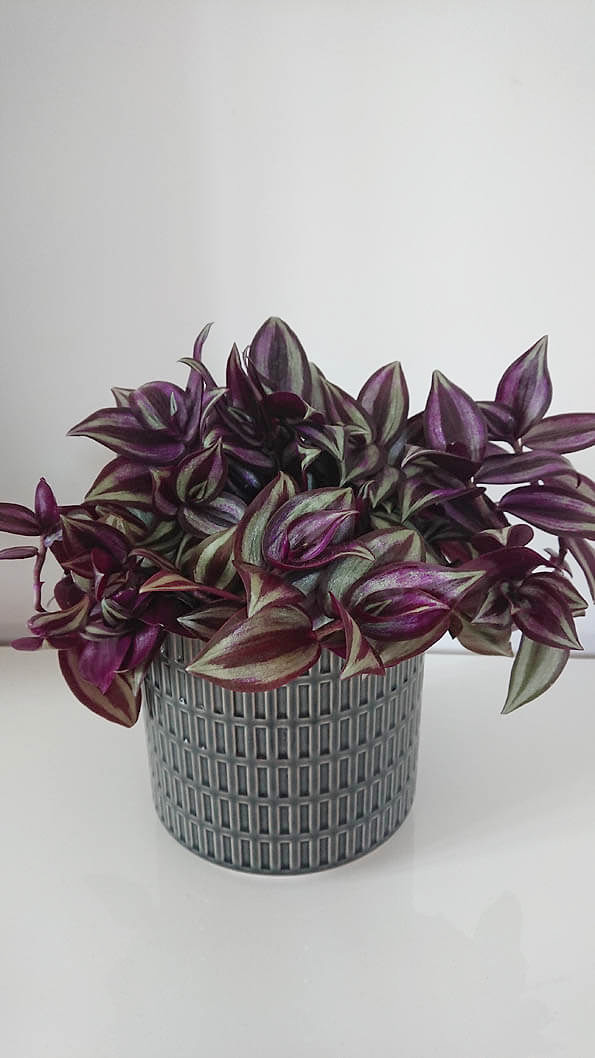
Tradescantia make for excellent houseplants as they fit into almost any design scheme
" Wandering Jew Plant for sale " and " How do I care for my Wandering Jew plant? " are two big hitters when it comes to our visitors asking us questions about this popular and easy care houseplant. We would suggest Amazon.com or Amazon.co.uk or our Where to Buy article to kick start the buying hunt, and our article below will (hopefully) answer the care question for you.
The common names are based around the plant's ability to easily spread itself.
To start things off, a lot of people also want to understand the common names this plant goes by - the Wandering Jew Plant and the Inch Plant . Both names are centered around its ability to spread and grow very quickly, with little care or intervention from people.
Pro Tip - This is truly one of the simplest houseplants to propagate. From taking cuttings, you can have fully grown plants in less than 6 months.
The Wandering Jew is a legend that basically follows that a Jewish man was cursed to walk the earth forever, therefore like this plant the Jew will, in time, eventually go everywhere .
A number of visitors have contacted us to say the use of this common name today could be misconstrued or even upset Jewish people.
Unfortunately we've not been able to find any specific use of this common name being deliberately used by houseplant owners (or the horticultural industry in general) in an anti-Semitic way (from what we've seen at least). When talking about this plant directly even a Rabbi feels that the name is probably not used with conscious anti-Semitic malice .
That being said, the use and choice of words is often important. Our website is about houseplants and the joy they can bring, and without even trying, this hobby is a very inclusive pastime for everyone.
Our communication to you therefore should reflect this. We'll continue to monitor the common name and use one of the alternatives on our social media channels such as Wandering Dude .
The " inch " plant name probably comes from a combination of the stem's ability to grow about an inch every week, and also because only an inch of this plant is needed to propagate itself.
There are several popular varieties of Tradescantia Zebrina for sale each sharing the recognisable glistening leaf surface and purple underside. T. zebrina 'quadricolor' has green, silver, pink and red leaf markings, whereas T. zebrina 'purpusil' has a green and purple blend.
Tradescantia fluminensis is a very close relative to T. Zebrina (or Zebrina pendula as it used to be called) and is also known as the Wandering Jew Plant. Although it's much less popular these days, its care requirements are identical to T. Zebrina except it will cope better with a slightly darker position.
Where to Buy? - Where can you buy all these interesting varieties you ask, that's easy, check out these Etsy Sellers! * You can also find a broad range as well as some more unusual types over on eBay * * We'll sometimes earn a small commission when you buy something through the affiliate links on our site.
It has smaller leaves compared to its bigger cousin and more green in the leaves. T. fluminensis is therefore very plain looking so search out some of the varieties instead such as T. fluminensis 'variegata' or T. fluminensis 'quicksilver ' or T. fluminensis 'Tricolor', these have cream and white stripes to give it a bit more of a visual punch.
You may find several types growing all in one pot for an extra hit. As the care requirements for each is pretty much the same you can leave them clustered together like this (providing you like this look of course).
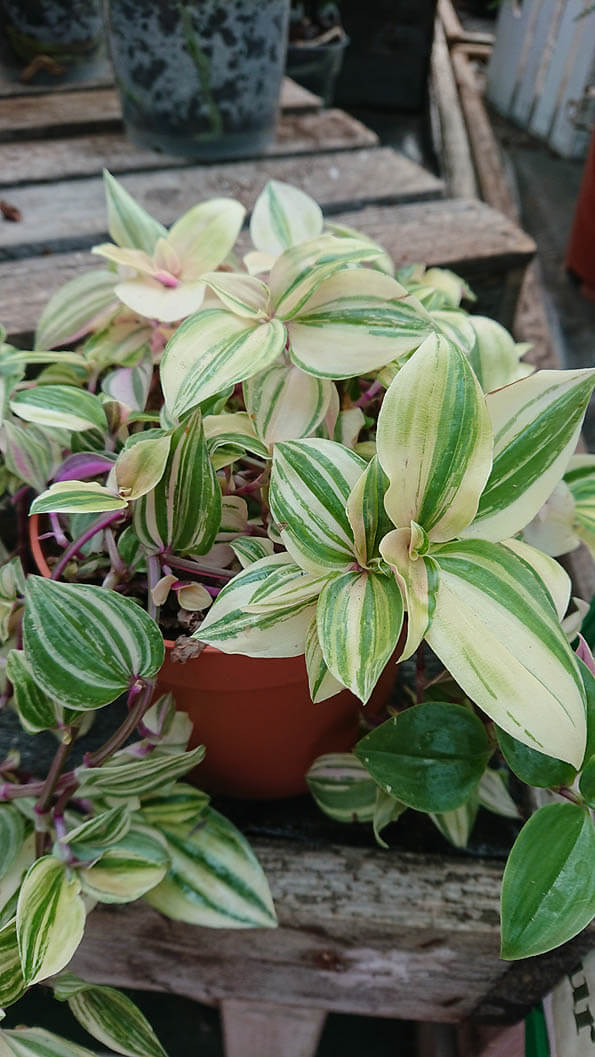
Variegated Tradescantia are becoming much easier to find
We should mention that the Wandering Jew Plant outdoors tends to become an invasive species if not properly maintained, as it's difficult to eradicate because if only an inch of it survives it will live on.
That said, our focus is on the indoor grower and so its potentially invasive nature outdoors isn't a problem. The Wandering Jew Plant is safe to have around cats and people, the sap in the leaves and stems, however, can be irritating so either wear gloves or wash your hands immediately if you come into contact with this.

Hi, I'm Tom!
If you're like me and enjoy the challenge of growing houseplants and getting them to thrive, then Ourhouseplants can help. This website shares my knowledge and years of growing plants and provides (hopefully) helpful advice on properly caring for your indoor plant friends.
Wandering Jew Plant Photos
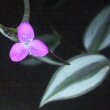
Wandering Jew Plant Care Guide
All Tradescantias including the Wandering Jew Plants need plenty of light to retain the variegated colours on the leaves, if things are too dim these will fade.
On the other side of the coin if too much light is provided leaf scorching is the end result, fortunately however the problem of " too much light " is basically only caused by excessively exposed locations during midsummer.
This is quite hard to provide indoors anyway, so you will only really risk this if you Summer your plants outdoors.
It's important they're placed in plenty of light but protected from very strong sun .
As you would expect from any easy houseplant, the Wandering Jew will cope with droughts and a little water logging from time to time.
Try to avoid this careless watering approach where possible though as a good looking plant needs to be watered correctly. The instruction here is simple, water your Tradescantia regularly and freely during the warmer seasons to try and keep the soil moist for much of the time.
In Winter cut right back because growth will slow or stop completely and the need for water will reduce drastically as a result.
The leaves are almost succulent like and therefore humidity is something you don't have to worry about a great deal. It will be worth misting the plant however if you start to notice the leaves becoming shriveled or brown leaf tips start to appear. You can also grow Tradescantia in an indoor bottle garden .
The opinion is often divided about how much and how often you should feed Wandering Jew Plants.
Some will suggest regular heavy feeding, perhaps as much as every other watering and others will say only once or twice a year at most, otherwise it will encourage the variegated leaves to turn green. The truth of it is that this plant will cope with almost anything you give (or don't give) it.
We fertilise normally (back of the bottle instructions) once a month and the OurHousePlant.com's Inch Plant is as good looking as the day it was brought.
Temperature
Give your plant average warmth conditions for quick growth, a cooler room of around 10°C (50°F) is also suitable too. In fact, the only no no, is exposure to frost or really chilly temperatures for prolonged periods. Frost will do serious damage and chilly locations will cause leaf discoloration.
It's best to repot once a year to give a little more space for the roots to grow, but as with everything else to do with this plant, it will still cope living in the same soil for years. This is handy if you've chosen to grow it in a hanging basket as these can be fiddly to upsize and can also be a little difficult to work with.
When you do repot though, normal potting soil is a great choice, just make sure you avoid mixes with a heavy manure content and don't use ordinary dirt from your yard.
Propagation
When it comes to propagation of Wandering Jews only the Spider Plant is easier and more reliable to work with. The success rate of Spider Plants is something like 99% and the Wandering Jew, 98%, so either way it's still incredibly easy to grow more plants.
You don't need a fancy heat mat or any special containers or tricks. You don't need to use any type of rooting hormone, and it's literally just a case of pushing the cutting a few centimeters into a fresh potting mix, water well and away you go. Trust us, once you know what you're doing it's so easy to do. Below is a break down of each step.
The stems of a mature plant are quite brittle so an accidental knock or an intentional snip on an existing plant will mean you have a Wandering Jew Plant stem cutting almost ready to go.
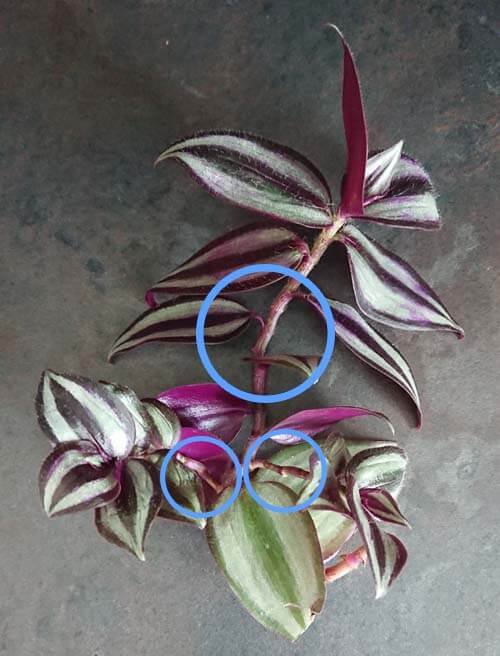
This broken stem can be used to create multiple plants
You don't need to wait for the fresh cut end to dry out so you could just push it into some soil (even in the existing pot where it was growing before if you're trying to recreate a bushy appearance).
But just replanting the large stem is potentially wasteful as there are several individual plants that can be created from a broken stem, like the one shown in the photo, this cutting could easily become three plants.
The photo above shows three sturdy stems with blue circles around them. Snip them off, making sure each is an inch long and has at least one leaf , although ideally for quicker results you will want a cutting that is several inches long and several leaves already in place.
Trim off any leaves on the lower part of the cuttings , because if any leaves touch the soil they will quickly rot, which could then cause the entire cutting to fail. Instead, remove the lower leaves and discard any unused material.
Below you can see the results of the above instructions - Three cuttings created from the original big one that are now ready to be planted up.
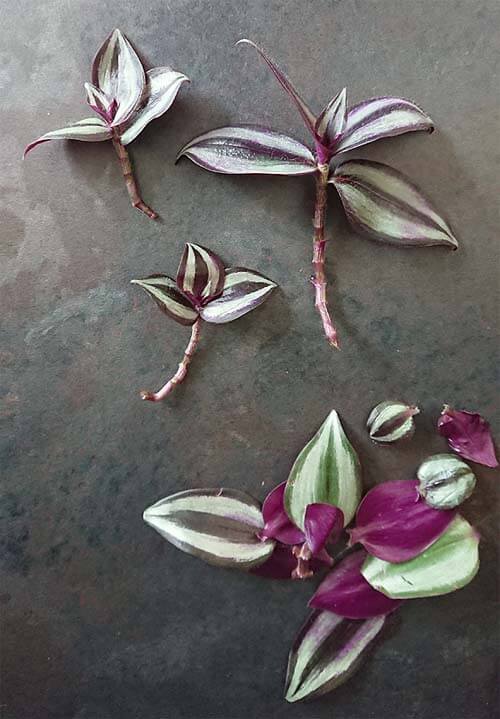
Several sections have been created and the lower leaves removed
Simply fill a container with potting soil or compost and wet it before inserting the stem ends into the soil. Make sure the cuttings are reasonably stable and fixed in place as they need good contact with the soil to stimulate root growth.
Pro Tip - Cuttings will take time to become bushy and to fill a pot by themselves, so because of the ease at which propagation can be done it's usually more effective to take several cuttings and put them all into the same pot.
You can use a rooting hormone, but we've found standard cuttings root with a very high probability anyway so don't bother.
Cuttings do much better if they don't touch each other and if they're planted towards the edges of the container rather than right in the center. Doing this will discourages rotting and the outer edges tend to be warmer than the very heart of the pot which gets the roots growing faster.
Once in place keep the soil moist (but not wet or soggy) and keep the plant warm. New growth should appear in just a few weeks. If you decided to grow several cuttings in a single pot and you notice any gaps later on, you can just push in new cuttings whenever needed to make it bushier.
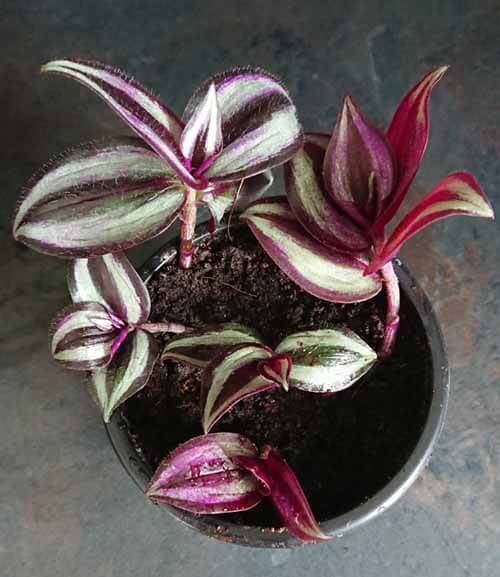
The cuttings planted up into a pot of compost
You can, of course, grow your individual cuttings in their own pots if that's what you'd prefer to do, but by putting several together like in the photo above it will mean after just a few months this pot will be completely covered with new growth.
All these cuttings will have knitted together nicely to give the illusion of one full plant when in fact it's actually several. This is something that would take almost a year or more if you're going for one stem cutting per pot.
Speed of Growth
The growth rate of Wandering Jew Plants when temperatures are warm is fast. As much as an inch a week in the growing seasons, if good light levels are provided and its watering needs are being met.
Its natural tendency is to "vine" and spread out, so if you aren't growing this in a hanging basket or you want to grow a neat compact looking plant then you must prune regularly to keep it tidy (don't forget the pruned stems can be used to propagate new plants).
Height / Spread
The height of this plant won't ever go beyond 6in / 15cm however every single stem can eventually grow to 6ft / 1.8M.
This type of spread might be what you're looking for of course i.e. if you want it to trail down from a hanging basket perched up high. However the stems can always be kept shorter by pinching out the growing tips on a frequent basis.
The Wandering Jew Plant is another houseplant that is grown for it's foliage rather than the flowers it produces, however they can still add a nice touch when they appear.
The pink or purplish flowers these plants produce will be small and can appear at any time of the year, although it's much more likely in late Spring early Summer.
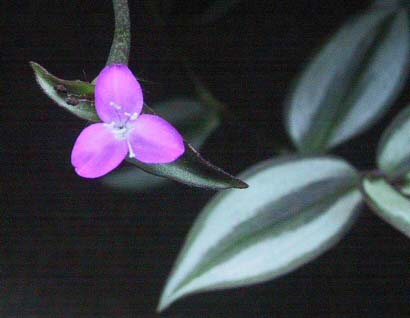
Inch Plant's aren't normally grown for their flowers, but they'll still bloom indoors sometimes
Are Tradescantia Plants Poisonous?
Generally speaking, Tradescantia is very mildly toxic to pets and people.
While it does little harm if eaten, the sap within the leaves and stems can cause contact dermatitis on the skin, especially in those with sensitive skin or those with an allergy . Wash your hands quickly after handling and you shouldn't have any issues.
Anything else?
Your plant is looking tired, it's become leggy and unattractive, convinced you have done something wrong you Google " Wandering Jew care instructions " to try and find out how to fix things. The answer you'll find will be pretty much the same everywhere because as any seasoned owner of this plant will tell you, this " look " is inevitable.
The vines grow long and quickly. Over time as they age the older leaves yellow and fall off creating the appearance you feel you've caused through poor treatment, which isn't usually the case.
Basically what's happened is that the plant has pushed and spread itself away from the pot it was growing in.
You can start again by taking cuttings and next time prune more frequently to encourage everything to keep closer, compact and neat.
Caring for Wandering Jew Plants Recap
Good Light Needed To keep the beautiful markings you need to provide good to bright light. Avoid direct sun exposure and low light conditions.
Average Watering Tolerant of a wide range of watering styles, it secretly wants to be well watered and for the soil to be moist for much of the time.
Average Temperature Provide temperatures at or above 18°C ( 65°F ) for best results.
Feeding Feed the soil once a month during Spring and Summer.
- No direct sunlight or low light positions
- Do not try and grow your plant in very cold places
Wandering Jew Plant Problems
Normally this is down to age, the oldest leaves will yellow and fall naturally. Although if this happens and you notice there are limp stems too then this is likely to be caused by quite prolonged and extreme underwatering.
Leaves changing to green / lost variegation
Although you can buy a green leaved variety of Wandering Jew, the majority are variegated and therefore if the leaves are changing colour this is obviously a problem.
The cause is almost certainly too little light. Overwatering can dull the colours but this doesn't make them go completely green. The cure therefore is to move the plant to a brighter area in your home.
Crispy brown and translucent leaves
Sometimes you'll find dead brown crispy leaves or some leaves going yellow or translucent, as shown in the photo below.
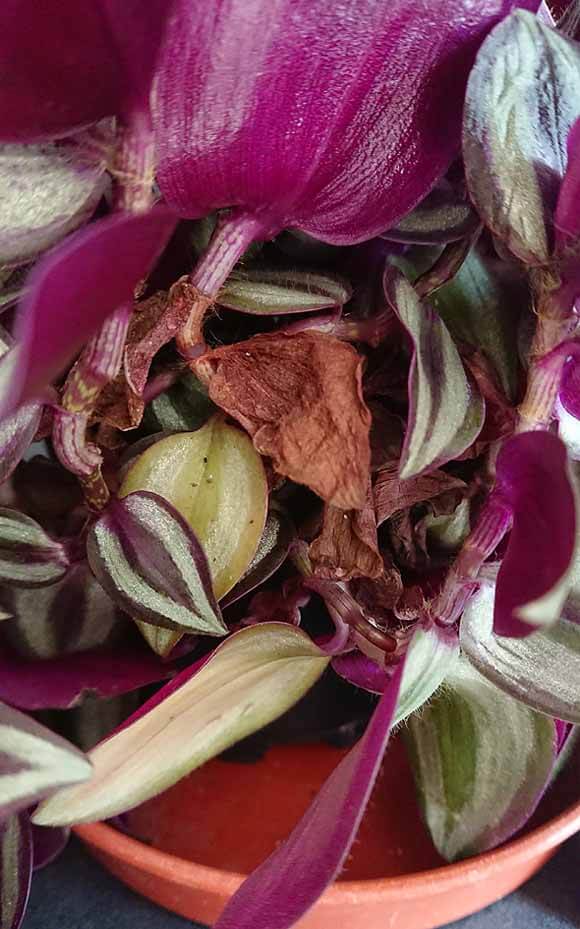
Tradescantia houseplant with unhappy leaves
This is going to be caused by one of the following (or in some cases a combination).
- Natural Ageing . Close to the heart of the plant tend to be the oldest leaves which are likely receiving very little light due to the shade from the canopy of the outer leaves. It's sensible for the plant to shed these leaves as they're not serving any propose. These leaves should pull off easily, so just remove them.
- Too much light . Excessive direct burning sunlight will quickly scorch and destroy the leaf. These plants want bright light but not full sun.
- Underwatering . Too little water can cause leaves to crisp and dry out. Make sure you're giving your plant ample water during the growing months.
Wandering Jew Plants love water when growing strong, but as with the majority of indoor plants too much watering will eventually rot the stems. Keep the soil moist not water logged.
Bare spindly and / or leggy growth
This is typically the issue discussed in the " anything else " section above, i.e. this appearance is usual after the plant is quite old. It may also be caused however by too little light (the variegation will have faded also), too little water on a regular basis (accompanied with yellowing leaves), or not enough fertilizer .
Wandering Jew Plant leaf tips are brown and shriveled
Although quite unusual in most homes this is caused by placement in a room with very low humidity, i.e. the air is too dry. You might also be trying to grow your plant next to a heat source like a fire or heater.
Either move the plant somewhere else or follow some of our tips to increase humidity in the home. You should resolve this quickly as your Wandering Jew Plant will also be easy prey for Red Spider Mite infestation.
About the Author

Over the last 20 years, Tom has successfully owned hundreds of houseplants and is always happy to share knowledge and lend his horticulture skills to those in need. He is the leading content writer for the Ourhouseplants Team .
Also on Ourhouseplants.com
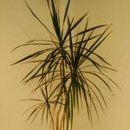
(Article / Gallery) Photo credit of the Wandering Jew T. fluminensi to LucaLuca (Article / Gallery) Photo credit of the Wandering Jew flower to Ruestz
About Ourhouseplants.com
Our website is for anyone looking for success with indoor gardening.
With care guides and information about all popular indoor plants, we're here to help get your houseplants thriving. From the beginner to the more experienced, there's something for everyone.
As a Team, we've almost 50 years of hands-on experience and various horticulture skills. So let us help you to grow your knowledge and become a houseplant expert.
Six Reasons You Can Trust Us
- Recent Updates
- Privacy Policy
- © OurHouseplants.com - 2013 - 2024

How to grow and care for tradescantia
- Tamsin Hope Thomson
Find out how to grow and care for tradescantia, in our Grow Guide.
- Share on facebook
- Share on twitter
- Share on pinterest
- Share on whatsapp
- Share on blogger
- Email to a friend
Tradescantia has more than 65 species, native to North, Central and South America. Many are hardy and can be grown outdoors but several of the tropical species, which are tender, have become popular house plants in the UK. These include the variegated silver-striped Tradescantia zebrina, Tradescantia fluminensis , which has small leaves, trailing stems and white flowers, and Tradescantia cerinthoides 'Nanouk', with variegated pink and purple leaves that have green and white stripes.
They do have 3-petalled flowers that can be white, blue, lavender, purple or pink, but tradescantia house plants are grown mainly for their foliage. The flowers will usually appear in the summer if plants are provided with sufficient bright light. Too much sun, however, can result in the leaves developing a purple colour, while for the purple-leaved varieties, a lack of light can result in the purple foliage fading.
This colourful plant was named by Carl Linnaeus, in honour of John Tradescant, and his son, who had the same name. Both were plant hunters and explorers during the 17th century, discovering many new plants that were grown in British gardens. Tradescantia also has many interesting common names including inch plant, spiderwort and wandering Jew. This latter name has been replaced by many nurseries with the name 'Wandering Dude' due to its antisemitic connotations. This is a good house plant that is easy to grow, as long as it is given the right growing conditions.
How to grow tradescantia
Tradescantia grows best in a spot that gets bright, indirect light. The soil should be moist, but not waterlogged. Water regularly, checking to see when the top couple of inches of soil are dry.
Where to grow tradescantia

The tender species of tradescantia are grown as house plants, although some can be grown outdoors during the summer and brought indoors over winter. Tradescantia zebrina , for example, can be moved outdoors during summer, but should be brought indoors when the temperatures drop to around 10ºC. Indoors, tradescantia house plants need bright light, but not direct sunlight.
More like this
These house plants are well suited to hanging planters indoors, or shelves, where their attractive, trailing foliage can hang down and be appreciated.
How to plant tradescantia
Use a good quality potting compost when repotting your house plant. Check the bottom of the pot once a year, to see whether it needs repotting – if there are lots of roots coming out of the holes it may need a slightly bigger pot.
How to care for tradescantia

Keep tradescantia in a warm room that has a temperature between 18-24ºC and place it away from any draughts. In the summer, water regularly, when the top few inches of compost have dried out. The best way to water a tradescantia to avoid water sitting on the leaves, is to bottom water it – place it in a saucer of water and wait for it to absorb as much as it needs. Reduce watering during the winter. Feed once a month with a general house plant fertiliser, during the growing season.
Plants will thrive in humid rooms such as a bathroom or kitchen, but in other rooms you can mist every few days to increase humidity. If you notice the tips of its leaves turning brown, a lack of humidity could be the problem.
It's easy to prune tradescantia, simply cut back stems to the length you want them to keep the plant compact. The best time to prune your house plant is during the growing season.
How to propagate tradescantia

Tradescantia can be propagated by taking stem cuttings. Cut off a 10cm piece of stem, just below a leaf joint. Snip off the lower leaves from the cutting and place it in a jar or glass of water. Place the jar in a warm position and once it has developed roots, it can be planted into a small container of potting compost.
Pests and diseases
Tradescantia is generally disease free but can be prone to pests such as spider mites, mealybugs, aphids and thrips.
Spider mites – look out for webs on your plants and remove any parts of the plant that are particularly affected. Raising the humidity around your plant will help as spider mites thrive in dry conditions.
Mealybugs – you might notice small woodlice-type pests or a fluffy white substance. Remove by hand or try biological control, and remove any fallen leaves that may harbour the pest. It may be necessary to throw out badly infested plants.
Aphids – remove sap-sucking greenfly and blackfly by hand or by spraying with water.
Thrips – also known as thunder flies. Raising the humidity will help to deter them but large infestations may be removed using a soap-based solution.
Advice on buying tradesantia
- Tradescantia is also sold under the names silver inch plant and spiderwort.
- Always check plants for signs of pests, damage or disease before planting. Tradescantia can be prone to spider mites
Where to buy tradescantia
- Patch Plants
- Thompson & Morgan
Varieties of tradescantia to grow

Tradescantia zebrina (silver-inch plant) – silver-striped leaves on trailing stems make this plant an attractive option for a hanging basket or pot on a shelf.
Height x Spread: 60cm x 30cm
- Buy Tradescantia zebrina from Crocus
Tradescantia cerinthoides 'Nanouk' (Moses in the cradle) – this variety has green and cream leaves that have a rich purple underside, and white flowers
H x S: 40cm x 1m
- Buy Tradescantia cerinthoides 'Nanouk' from Happy Houseplants
Tradescantia pallida 'Purple Heart' (purple-heart spiderwort) – a vibrant purple-leaved variety with 3-petalled purple flowers during the summer.
H x S: 20cm x 25cm
- Buy Tradescantia pallida 'Purple Heart' from House of Kojo

Subscription offer
Subscribe today and get a £10 M&S e-gift card.

September issue on sale now!
The September issue of BBC Gardeners' World magazine is on sale now, buy online or in stores now.

Lunch at Le Manoir aux Quat’Saisons, with cookery and apple pressing demos
Join the BBC Gardeners' World Magazine team for a day of discovery at the famous Le Manoir aux Quat'Saisons, a Belmond Hotel.
Friday 20 September 2024, £285pp

Home » House Plants » Wandering Jew
Tradescantia Nanouk Care: Growing The Nanouk Wandering Jew

Tradescantia Nanouk® (trad-es-KAN-tee-uh NAN-uhk) is also known as Fantasy Venice and Tradescantia albiflora ‘Nanouk’ (al-BIH-flor-uh).
This Nanouk Tradescantia plant is a new cultivar developed by cross-pollinating two selected seedlings of Tradescantia albiflora . It is a patented plant with the United States Patent number PP29711.

“Nanouk” has a few other common names, such as Nanouk tradescantia, Fantasy Venice, Wandering Jew, Spiderwort, and Tradescantia bubblegum.
This trendy plant was developed in the Netherlands in 2012 through a planned breeding program focused on creating a more compact type of Tradescantia with impressive flowers and highly dependable performance.
Although Tradescantia plants originated in Mexico, South America, and Central America, it can truly be said that this plant originated in Sappemeer, The Netherlands.
All Tradescantia plants are herbaceous perennials and are members of the plant family Commelinaceae (ko-mel-ih-NAY-see-eye).
“Summary of Invention” For Tradescantia Nanouk® as filed with the US Patent Office on March 28, 2017
The following traits have been repeatedly observed and are determined to be the unique characteristics of ‘Nanouk.’ These characteristics, in combination, distinguish ‘Nanouk’ as a new and distinct Tradescantia plant:
- Compact and upright to broadly spreading plant habit.
- Strong and healthy leaves.
- Light purple, green, and greyed green-colored leaves.
- Good interiorscape performance.
Plants of the new Tradescantia and the parent selections differ primarily in leaf color, as plants of the parent selections have white and green-colored leaves.
Plants of the new Tradescantia can be compared to plants of the Tradescantia spathacea ‘Tricolor,’ not patented. In side-by-side comparisons, plants of the new Tradescantia and ‘Tricolor’ differ primarily in leaf shape as plants of new Tradescantia have shorter and more rounded leaves than plants of ‘Tricolor.’
Plants of the new Tradescantia can also be compared to plants of the Tradescantia albiflora ‘Albovittata,’ not patented.
Nanouk Plant Quick Care Tips
- Botanical Name: Syngonium podophyllum
- Common Name(s): Nanouk Plant, Arrowhead Plant
- Synonyms: N/A
- Family & Origin: Araceae family, native to Mexico, tropical rainforests of Central and South America
- Growability: Easy to grow
- Grow Zone: USDA zones 10-12
- Size: Grows up to 2-3′ feet tall and wide
- Flowering: Rarely flowers indoors
- Light: Bright, indirect light
- Humidity: Prefers high humidity, mist regularly
- Temperature: Keep in temperatures between 55-75°F
- Soil: Well-draining soil
- Water: Water when the top inch of soil is dry, do not overwater
- Fertilizer: Fertilize once a month during growing season with a balanced fertilizer
- Pests & Diseases: Susceptible to spider mites, mealybugs, and scale insects. Can also be affected by root rot if overwatered.
- Propagation: Propagated through stem cuttings in water or soil
- Plant Uses: Great for adding greenery to indoor spaces, can also be used in terrariums or as a hanging plant.
In side-by-side comparisons, plants of the new Tradescantia and ‘Albovittata’ differ primarily in leaf color, as plants of ‘Albovittata’ have white and green-colored leaves. [ source ]
Grooming and Maintenance
Taking stem cuttings – propagating tradescantia, is nanouk considered invasive, tradescantia nanouk care, size and growth.
Nanouk Tradescantia has a very compact and upright growth habit and spreads freely. It is considered a fast grower. The plant typically reaches a height and width of just under three-and-a-half inches.
The plants’ stems are thick, and the leaves are smooth on the top and a bit furry on the underside. Green, pink, and white stripes on large, lush leaves with cute little white and yellow flowers that grow from pink buds.
The variegated leaves of Tradescantia Nanouk are impressively healthy, strong, and rather plump. Leaf coloration is quite lovely in shades of green, light purple, grayish green, pink, and cream.
Flowering and Fragrance
Flowers may be either pink or white and appear continuously throughout the plant’s growing season, which is spring through early autumn.
When kept indoors, Tradescantia Nanouk may also bloom through the winter months.
Nanouk Plant Care: Light & Temperature
Tradescantia albiflora ‘Nanouk’ does well in bright indirect sunlight or in full sun. Indirect bright light leads to greater flower production. Too little light will cause the foliage to fade.
Some direct sun is beneficial, but make sure not to overdo it since the leaves can get bleached or sunburned from too much direct sunlight.

If you want to increase the humidity, we suggest you mist it often, place it near a humidifier, or use a pebble tray.
The ideal daytime temperature for the Nanouk Tradescantia cultivar is between 55° and 75° degrees Fahrenheit. Outdoors, this Tradescantia is winter hardy in USDA hardiness zones 10 through 12.
Watering and Feeding
Overwatering is far more problematic than underwatering. Allow the soil to become almost dry, and then water thoroughly.
Generally speaking, Tradescantia Nanouk will do well with weekly watering. Never allow the plant to stand in water.
Tradescantia nanouk requires a moderate amount of water when planted in potting mix with good drainage. Allow the water to drain freely out a drainage hole, and then return the plant to its home!

As with most Tradescantia, this cultivar does not really need fertilizer. Over-feeding can lead to brown leaf tips.
If you do want to fertilize your plant, give it a half-strength solution of a good quality liquid houseplant fertilizer.
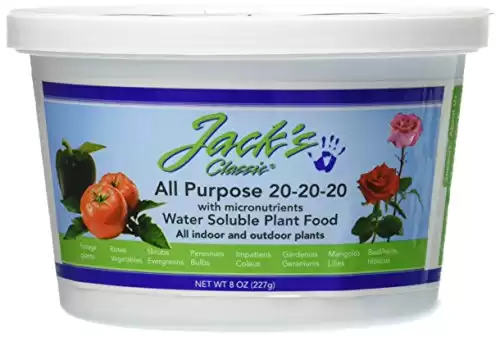
Alternately, give the plant a top dressing of vermicompost first thing in the spring.
Soil and Transplanting
Good drainage is a must. If your soil tends to be a bit heavy, add some perlite or coarse sand to lighten it up.
When potting your Tradescantia Nanouk, it’s important to use a standard well-draining houseplant soil mixed with coarse sand, orchid bark, or perlite.
Nanouk Tradescantia does well in any high-quality potting soil mix or container mix when kept as a potted plant.
You can improve the quality of the soil by adding organic matter such as compost, mulch, or peat moss.

Don’t worry if you have to do a bit of root ripping. Then plant each in separate small pots using well-draining soil.
You can also check if the roots are poking out of the bottom of the container. This is a sign that you should repot your plant.
Repotting is crucial for plant health because the old, oxygen-deprived, compacted soil is removed in this process.
When kept outdoors as a landscape plant, all of these caveats apply. Be sure that your soil is amended properly so that it supplies nourishment, holds the right amount of moisture, and allows excess moisture to drain away.
Even though Tradescantia Nanouk is bred to be compact, it still has some of its cousins’ sprawling and wandering habits. Keep the plant pinched back to encourage bushier growth.
Light pruning of dead and damaged foliage is recommended, and though fertilizing is not necessary, if you’d like to give your plants a boost, then it’s best to fertilize them in spring and summer.
Pinching new growth or cutting back your Tradescantia Nanouk will encourage it to grow fuller and bushier. The leaves will also be a bit smaller, with much more green and less variegation.
If your plant begins to sprawl and looks a little bit thin at the top, trim off leggy cuttings and poke them into the soil in the center of the pot. They will quickly take root and fill out your plant.
Tradescantia Nanouk Propagation
As with all Tradescantia, propagation is a breeze. Just trim off cuttings and start them in soil or in water.
Tradescantia Nanouk Pests or Diseases
Excessive watering is the main problem for all Tradescantia. Too much water can cause root rot and fungal infections. This may lead to trouble with fungus gnats.
Anytime your Tradescantia Nanouk plant seems to be less than healthy and happy, the first thing you should do is check to see if the soil is soggy. If it is, allow the plant to dry out completely before watering again.
Trim away any stems and/or leaves that seem to be damaged or rotten. You may also wish to take healthy cuttings at this time just in case root rot causes the demise of your main plant.
On the flip side, if you allow your Tradescantia Nanouk plant becomes too dry, you may experience trouble with spider mites.
These can be avoided by maintaining a correct watering schedule and by increasing humidity levels around your plants.
You can do this by misting and/or placing your plants on a pebble tray with a bit of water. Be sure the water doesn’t touch the bottom of the pot. It is intended to evaporate around the plants and increase humidity.
Spider mite infestation can be addressed by giving your plant a vigorous shower with fresh water.
Follow up by misting the plant with a 50-50 solution of water and isopropyl alcohol. You may need to repeat the misting several times to kill off all the spider mites and their eggs.
Is Nanouk Considered Toxic or Poisonous to People, Kids, and Pets?
The sap of all Tradescantia can be irritating to the skin and may cause gastric distress if ingested. Wear gloves when handling your plant and/or wash up immediately after you finish trimming.
Related: Have you ever wondered: Is Wandering Jew Poisonous?
Keep pets away from Tradescantia plants, as the sap can cause stomach upset if ingested and may cause dermatitis if it comes in contact with the animal’s skin.
Tradescantia of all sorts are considered invasive plants in the state of Florida. This type of plant naturalizes and spreads easily in any tropical environment.
Suggested Tradescantia Nanouk Uses
Tradescantia Nanouk can be used as a groundcover in tropical areas, but it was really developed to be kept as a houseplant.
It’s pretty colors and hardy leaves make it a good choice as a tabletop or desktop plant.
Another popular variation is the inch plant (T. cerinthoides), earning its name for its tendency to ‘‘inch along’’ as it grows along the ground or trails downward from a hanging planter.
It can do well in hanging baskets as it creates a fuller and more controlled appearance than other types of Tradescantia.
This pretty, colorful plant also does very well in mixed planters. The Tradescantia Nanouk plant is a perfect addition to any houseplant collection.
JOIN Our FREE Plant Care Newsletter
By entering your email address you agree to receive a daily email newsletter from Plant Care Today. We'll respect your privacy and unsubscribe at any time.
Wandering Jew Plants: Outdoor Or Indoor?
- Last updated Aug 30, 2024
- Difficulty Beginner
- Category Advanced gardening
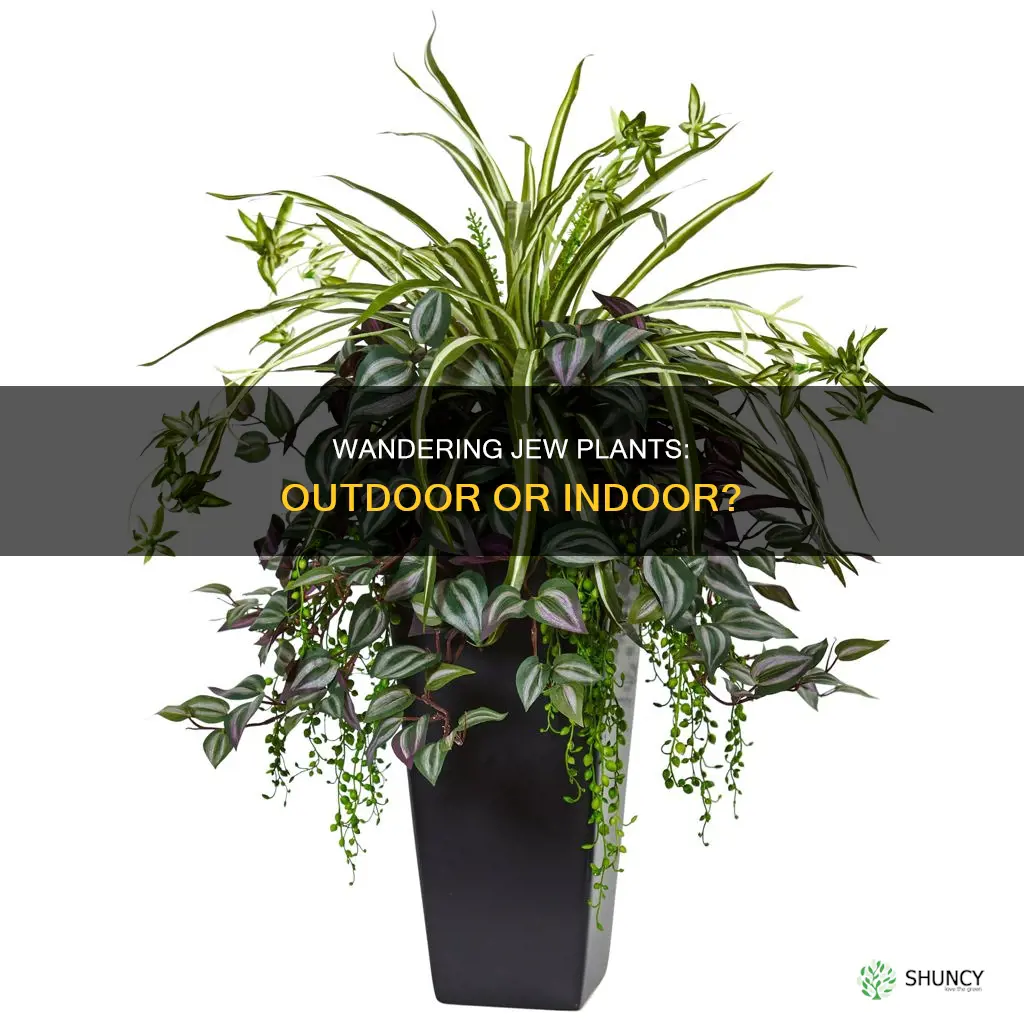
Wandering Jew is the name given to a variety of plants in the genus Tradescantia. It is considered invasive in many regions when grown outdoors, but its vining habit makes it ideal for indoor planting. The plants are hardy, grow quickly, and require little care and attention. They are characterised by their heart-shaped green leaves with purple stripes and a silvery sheen, and their small blooms with three petals, which can be violet, white, or pink. Wandering Jew thrives in bright, indirect light and temperatures between 60°F and 80°F, and should be kept away from frost.
What You'll Learn
Wandering jew plants are considered invasive when grown outdoors, the plants thrive in bright, indirect sunlight, the ideal temperature range for wandering jew plants is between 60°f and 80°f, wandering jew plants should be kept away from pets, the plants are susceptible to spider mites and aphids.

Wandering Jew plants, also known as inch plants, are considered invasive when grown outdoors. They are native to the subtropical regions of North and South America and thrive in warm climates. While they can be grown outdoors in USDA growing zones 9-11, they can quickly take over spaces inhabited by other plants and become invasive.
Inch plants prefer temperatures between 50-80°F (10-27°C) and do not tolerate cold well. They require partial shade during the day, as too much sun can cause their leaves to bleach and lose their distinct coloration. They also need moist, well-drained soil to thrive.
When grown outdoors, it is important to prune inch plants regularly to prevent them from spreading into other garden beds. Pruning at a stem joint can also provide new plants, as the stems can be placed in water to grow roots.
In certain regions, such as Hawaii, Brazil, and Australia, the Tradescantia zebrina species of inch plant is considered invasive due to its ability to thrive in damp, wooded environments. Therefore, it is essential to be mindful of the potential for Wandering Jew plants to become invasive when grown outdoors and to take the necessary steps to control their spread.
Iris: Flower or Plant?
You may want to see also
Wandering Jew plants, also known as inch plants, thrive in bright, indirect sunlight. They are native to the subtropical regions of North and South America and are well-suited for indoor and outdoor settings. While they can tolerate direct sunlight, their colourful foliage may fade, and their leaves may burn. Therefore, it is best to place them in a spot that receives bright, indirect light, such as an east-facing window or a covered porch or patio that gets plenty of light.
When growing Wandering Jew plants outdoors, it is important to provide them with partial shade, especially during the hottest part of the day. Too much direct sun can cause the leaves to bleach out and lose their distinct coloration. On the other hand, placing them in total shade should be avoided, as they will grow towards the nearest bright area, resulting in an uneven and scraggly appearance.
Wandering Jew plants are relatively low-maintenance and can grow well in various lighting conditions. However, providing them with bright, indirect sunlight will ensure their vibrant foliage and healthy growth.
- They prefer warm temperatures between 50-80°F (10-27°C) and do not tolerate cold well.
- The soil should be kept moist but not soaking wet.
- Fertilize biweekly during the growing season with a diluted liquid 10-10-10 fertilizer.
- Prune or pinch back leggy stems to promote bushiness and remove any diseased or dead leaves.
- Repot the plant when it outgrows its container, typically every year or so.
The Unsung Heroes: Nonvascular Plants' Alternative Names
Wandering Jew plants, also known as inch plants, are native to subtropical regions of North and South America. They are considered houseplants and thrive in bright, indirect sunlight. While they can be grown outdoors, they are sensitive to temperature changes and require partial shade.
On the other hand, extreme heat may scorch the leaves of the plant. When the temperature rises above 90°F (32°C), Wandering Jew plants will require more frequent watering. Providing partial shade during the hottest parts of the day can help protect the plant from excessive heat.
To ensure the health of your Wandering Jew plant, it is important to maintain a consistent temperature within the ideal range. This can be achieved by placing the plant in a spot that stays within the desired temperature range throughout the year or by moving it indoors during extreme weather conditions.
In addition to temperature control, Wandering Jew plants require well-drained, moist soil and partial to bright, indirect sunlight. They also benefit from regular watering and monthly fertilisation. With the right care, Wandering Jew plants can be a beautiful and colourful addition to your home or garden.
Plant Reproduction: Adaptation Strategies
Wandering Jew plants, also known as Tradescantia, are toxic to pets and should be kept out of their reach. The plants contain calcium oxalate crystals in their leaves and stems, which can cause skin or bowel irritation in cats and dogs, as well as vomiting and diarrhoea if ingested. The most common symptom of Wandering Jew poisoning in pets is a dermatitis-like skin irritation, which causes excessive scratching.
To protect pets from the toxic effects of the plant, it is advisable to place it in an area that is out of their reach. Hanging baskets are a good option, as the trailing vines will drape down nicely. However, it is important to prune the vines regularly to ensure that pets cannot access them. Placing the plant in a well-lit corner of a room that pets do not frequently enter is another option.
In addition to being toxic to cats and dogs, Wandering Jew plants are also considered invasive in many parts of the world when grown outdoors. The plants are native to subtropical regions of North and South America and prefer warm, slightly moist, and well-drained soil. They can tolerate both sun and shade but grow best in partial shade.
Plants: Oxygen vs Carbon Dioxide
Wandering Jew plants are susceptible to spider mites and aphids. Spider mites are the most common pests found on these plants. They thrive in warm, dry environments, so keeping humidity high or misting your wandering Jew plant can help to prevent an infestation. If this doesn't work, try giving the plant a good wash with water to knock the mites off. For severe infestations, remove the infested areas and use a systemic insecticide.
Aphids are another type of insect that feeds on the sap of wandering Jew plant leaves. If you're growing your plants indoors, take them outside and treat them with neem oil or a strong stream of water. Reapply treatments in 7 to 10 days if aphids remain.
In addition to pests, wandering Jew plants are also susceptible to various diseases, including root rot, leaf spot, botrytis, and powdery mildew. These issues are often caused by overwatering, so it's important to allow the soil to dry out slightly between waterings and to provide well-draining soil.
To prevent pest and disease problems, it's important to provide proper care for your wandering Jew plant. These plants prefer bright, indirect sunlight and moderate to high humidity. They should be watered regularly, allowing the top inch of soil to dry out between waterings. Providing adequate airflow and spacing between plants can also help prevent pest and disease issues.
Overall, wandering Jew plants are generally low-maintenance and easy to care for. However, they are susceptible to spider mites, aphids, and various plant diseases, so it's important to be vigilant and provide proper care to keep your plants healthy.
Sunflower Season: Planting Times and Tips for Buffalo, NY
Frequently asked questions.

- Jennifer Velasquez Author Reviewer Gardener

- Ashley Nussman Author Reviewer Gardener
It is awesome. Thank you for your feedback!
We are sorry. Plesae let us know what went wrong?
We will update our content. Thank you for your feedback!
Leave a comment
Advanced gardening photos.

Related posts
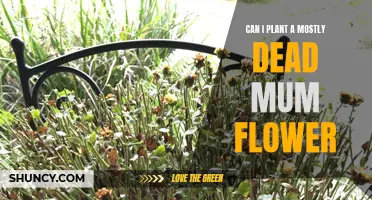
Reviving Mum Flowers: Planting Tips
- Jul 07, 2024

Morning Glory Blooming: Time and Care Tips
- Aug 19, 2024

Eradicating Scale Insects: Saving Your Plants
- Aug 10, 2024

Eradicating White Plage: Strategies for Fruit Plant Rescue
- Jul 24, 2024

- Jul 03, 2024

Feeding Plants: How Frequently Should You Feed Them?

COMMENTS
The wandering Jew plant is a common name for different species of plants that belong to the Tradescantia genus. There are around 75 different types of plants in Tradescantia genus and some are called inch plants, spiderwort, striped wandering Jew, Boat Lily, Purple Queen, or flowering inch plant. Wandering Jew plants are great house plants because they are relatively easy to care for.
Wandering Jew (Tradescantia zebrina) is a trailing evergreen perennial in its native habitat (USDA hardiness zones 9 through 12). Where it's not winter hardy, wandering Jew is grown year-round as a houseplant. Are wandering Jew plants toxic to cats and dogs? Wandering Jew is not considered outright toxic, but it can cause some skin irritation.
W andering Jew Plant Care. To keep your Wandering Jew plant thriving, ensure it receives bright, indirect sunlight. Keep it in average room temperatures of 60-75°F (16-24°C). Fertilize once a month during spring and summer. In winter, relocate the plant to a cooler area with temperatures of 54-59°F (12-15°C).
Tradescantia Fluminensis. This wandering Jew species features white flowers, and it's a trendy indoor plant around the world. The species originates from the southeastern region of Brazil. It's an evergreen perennial plant that flowers all-year-round and lasts for many years if the owner takes care of it correctly.
To care for a Wandering Jew plant indoors, place it in a location with bright, indirect sunlight, such as near a window. Water it when the top inch of soil feels dry, typically every 1-2 weeks, and provide well-draining soil. Additionally, mist the plant occasionally to increase humidity and remove dust from the leaves.
Repotting Tradescantia Plants. If your wandering jew is beginning to become a bit crammed in its pot, select a pot that's 1-2″ wider than its current one. Prepare your pot with a little fresh potting soil around the sides. Remove your inch plant from its existing pot, setting the root ball into the new one.
Tradescantia zebrina (Wandering Dude)
The Wandering Jew is a name that is used for several different species of plants in the Tradescantia genus, which includes at least 75 different species. In times past, gardeners would share cuttings from their Wandering Jew plants with friends and neighbors so, like its name, it traveled from place to place.
The wandering jew from the genus Tradescantia is a native of Mexico who earned its common name thanks to the plant's ability to root easily, spread, and thrive in a wide variety of conditions. This plant comes from the spiderwort family (Commelinaceae) and is also known as Zebrina pendula or inch plant.
Tradescantia zebrina, formerly known as Zebrina pendula, is a species of creeping plant in the Tradescantia genus. Common names include silver inch plant and wandering Jew. [1] The latter name is controversial, [2] and some now use the alternative wandering dude. [3] The plant is popular in cultivation due to its fast growth and attractive foliage.
The Wandering Jew plant is the common name given to a number of plants from the Tradescantia genus, including the scientific name Tradescantia Fluminensis, Tradescantia Pallida, and the most popular one - Tradescanita Zabrina.. The common name of "The Wandering Jew" is believed to come from a legend that the wandering jew 'taunted Jesus' en route to being crucified and was cursed to ...
One of the most exciting aspects of growing Tradescantia is the sheer variety of species available. With over 75 species to choose from, there's a Tradescantia to suit every taste. Popular houseplant varieties include Tradescantia zebrina, known for its distinctive striped leaves, and Tradescantia pallida, often grown outdoors in warmer climates.
The beautiful foliage of Wandering Jew Plant (Tradescantia zebrina) Soil Conditions For Wandering Jew Plants. Wandering Jew plants tolerate growing in a wide range of soils provided they drain well. Although they do tolerate and prefer moist conditions, the soil must drain properly to prevent root and stem rot from occurring. Therefore, it is ...
The Tradescantia genus contains 75 herbaceous perennials that are collectively known as wandering jew, or wandering dude. Among these are the well-liked houseplants Tradescantia fluminensis 'Quicksilver', Tradescantia pallida 'Purple Heart', and Tradescantia zebrina 'Tricolor', each of which is known by a variety of different common ...
Tradescantia pallida has vibrant purple foliage. Source: jam343. Originating in eastern Mexico, this particular species of wandering jew is a stunner. Its leaves, which are long and pointed, can reach up to seven inches in length. Sometimes the tips will remain red or green while the rest of the leaf turns purple.
Wandering Jew is the common name of a few different species: tradescantia zebrina, tradescantia fluminensis, and tradescantia pallida. All varieties of wande...
The Wandering Jew, Wandering Dude, Inch Plant, Spiderwort or Tradescantia Zebrina is a houseplant that can be grown in a hanging basket to show off its long beautiful trailing vines or kept contained and compact in a pot. Very versatile, very easy and very hard to finish off, makes this a very good indoor plant to have around.
Tradescantia fluminensis is a species of spiderwort native to South America. It is one of several plants known by the common name wandering Jew . It is also known as small-leaf spiderwort , [ 1 ] river spiderwort , inch plant , speedy Henry , [ 2 ] wandering willie [ 3 ] and wandering trad .
Both were plant hunters and explorers during the 17th century, discovering many new plants that were grown in British gardens. Tradescantia also has many interesting common names including inch plant, spiderwort and wandering Jew. This latter name has been replaced by many nurseries with the name 'Wandering Dude' due to its antisemitic ...
"Nanouk" has a few other common names, such as Nanouk tradescantia, Fantasy Venice, Wandering Jew, Spiderwort, and Tradescantia bubblegum. This trendy plant was developed in the Netherlands in 2012 through a planned breeding program focused on creating a more compact type of Tradescantia with impressive flowers and highly dependable performance.
Wandering jew plants are super easy to propagate. Take cuttings that are 3-4″ long, and include a couple of leaf nodes. Dip the cut ends into rooting hormone, then stick them in moist soil. Don't allow the soil to dry out, and keep the air around the cuttings humid. A propagation chamber makes this simple.
Tradescantia fluminensis 'Quicksilver' has variegated white-green foliage and sometimes produces white flowers. Tradescantia ... Could do without the wandering Jew name. trandescantia zebrina formerly Zebrina pendula is much more fitting for this lovely plant. Reply; tabitha (not verified) 5 years 5 months ago. I only had one small vine ...
Related Post: How To Prune A Wandering Jew Plant (Tradescantia) Closeup of leaf node on wandering jew. Preparing Tradescantia Cuttings For Propagation. To prepare your wandering dude cuttings for propagation, remove any leaves from the lower section to expose a few inches of the stem. You can do this by snipping or pinching them off.
8 Cuttings- Rare Tradescantia 'Evanesce' Wandering Jew/Dude Plant ad vertisement by HappyPlants4You Ad vertisement from shop HappyPlants4You HappyPlants4You From shop HappyPlants4You $ 7.95. FREE shipping Add to Favorites 10- Cuttings, Tradescantia Burgundy Dark Desire Purple Wandering Jew/Dude Plant ad ...
Wandering Jew plants should be kept away from pets. Wandering Jew plants, also known as Tradescantia, are toxic to pets and should be kept out of their reach. The plants contain calcium oxalate crystals in their leaves and stems, which can cause skin or bowel irritation in cats and dogs, as well as vomiting and diarrhoea if ingested.